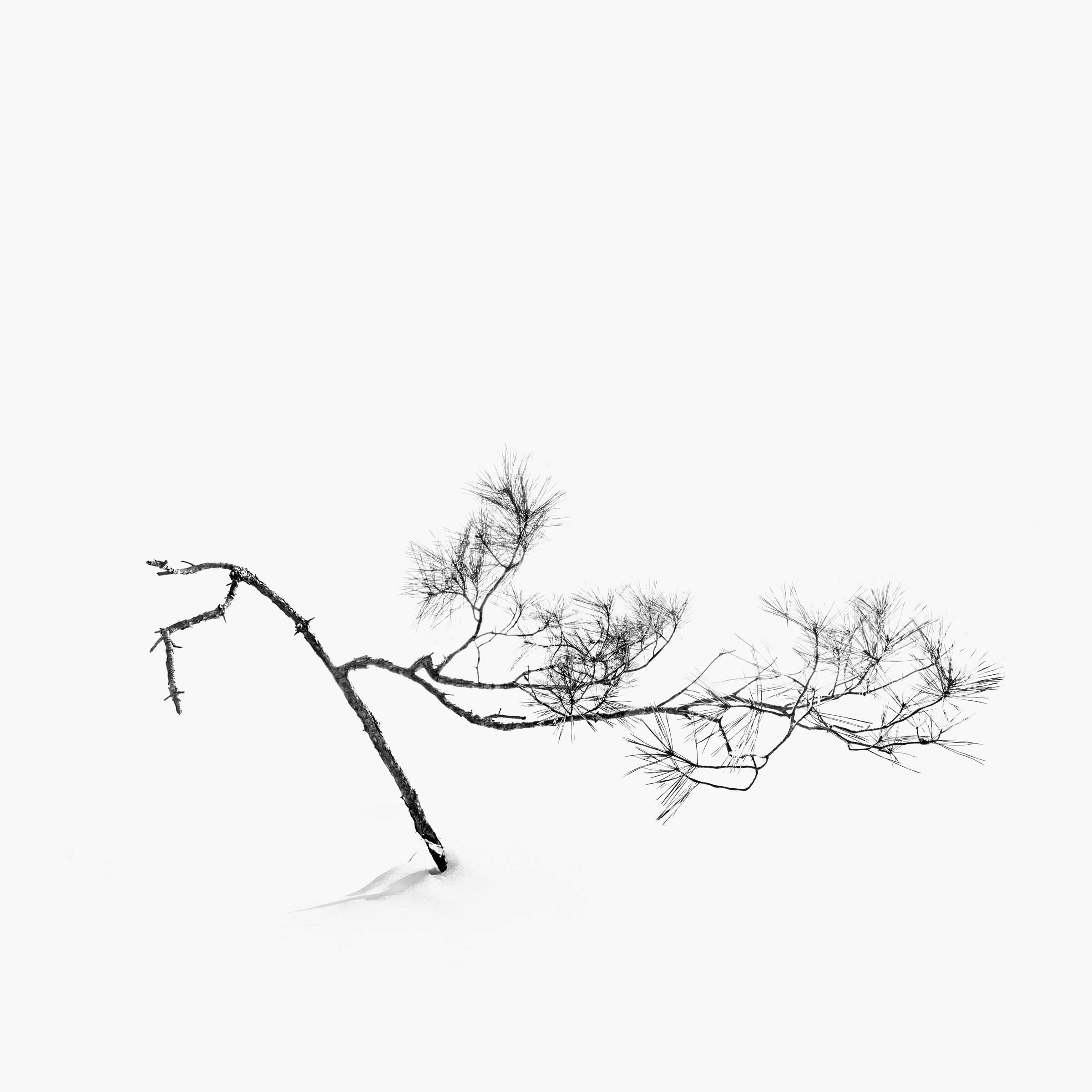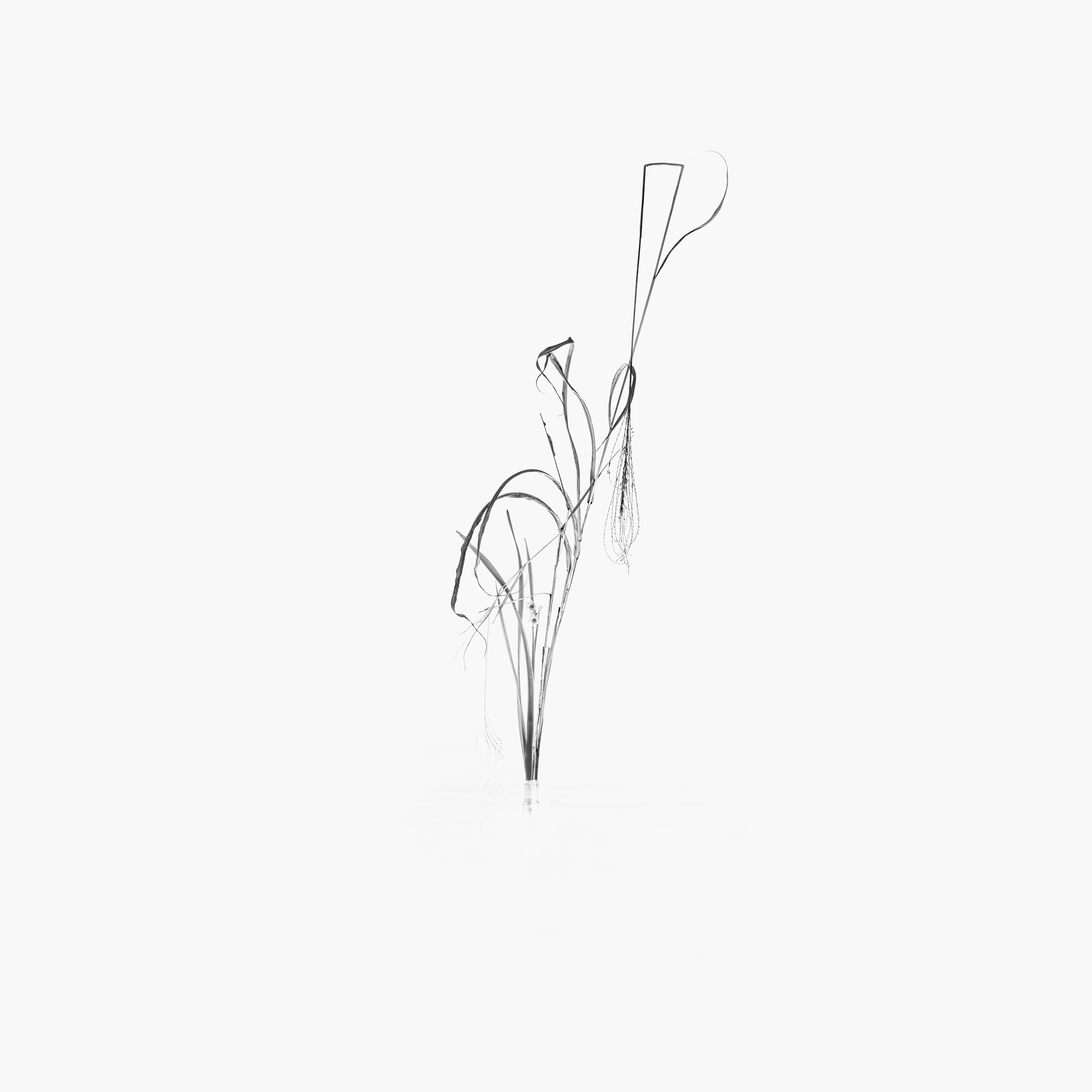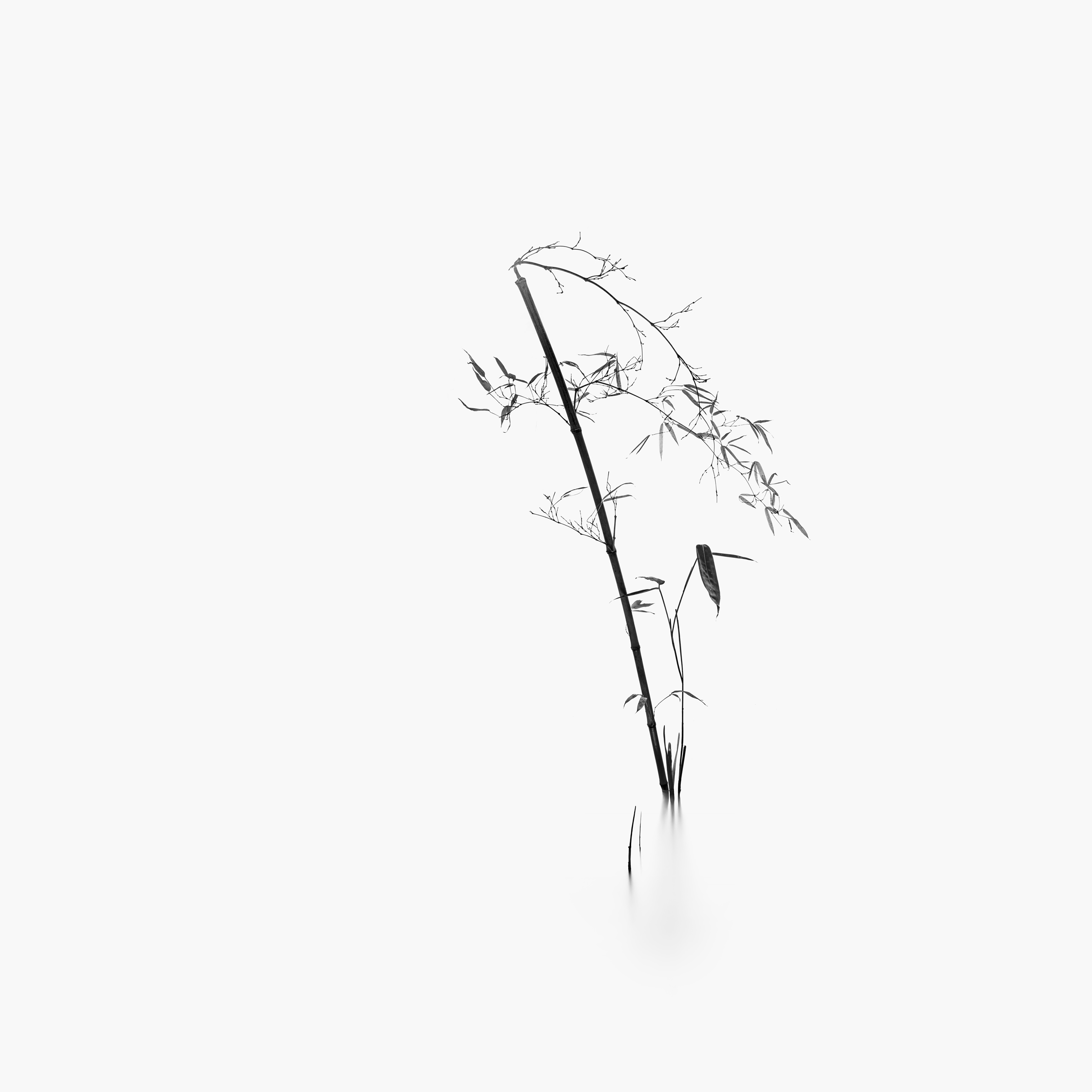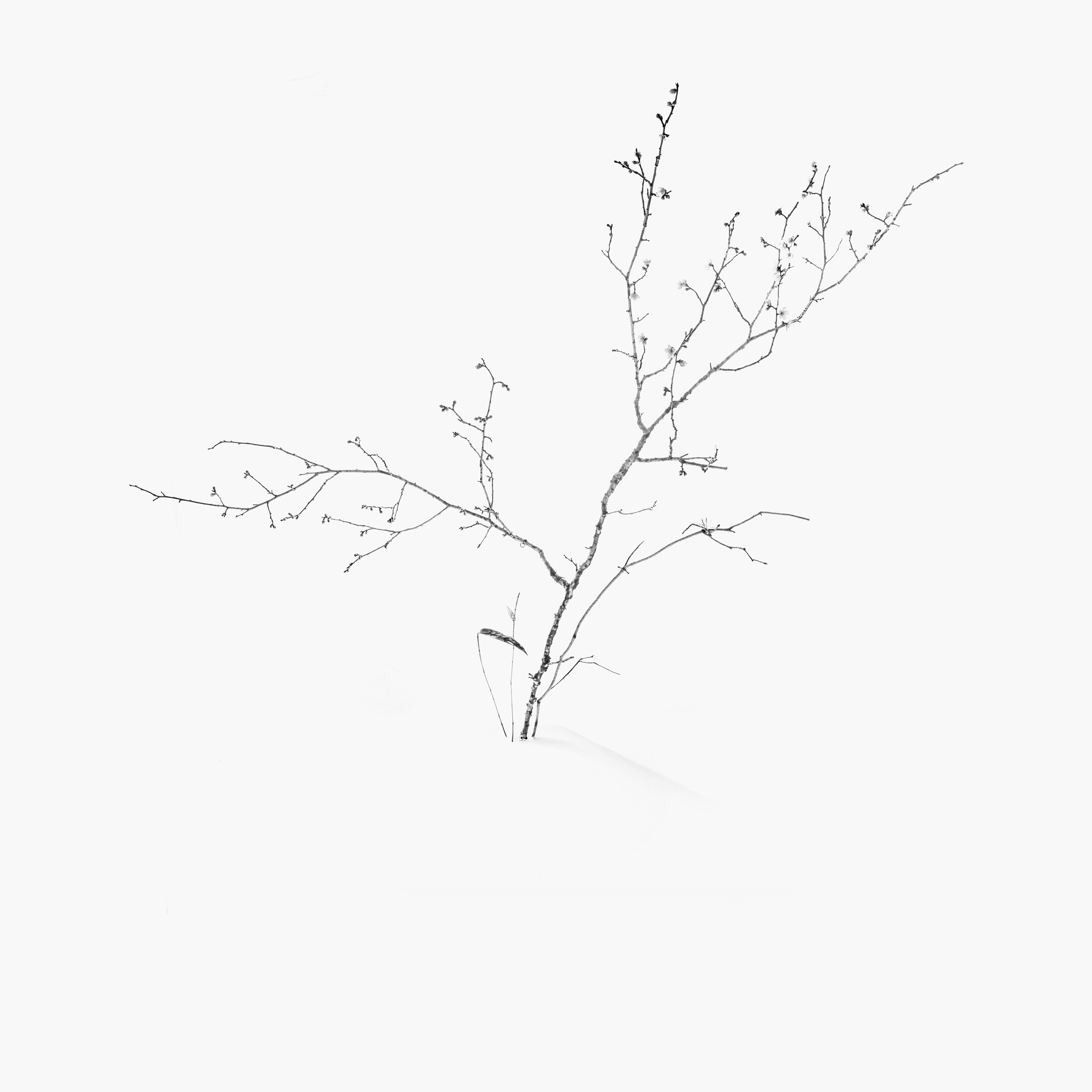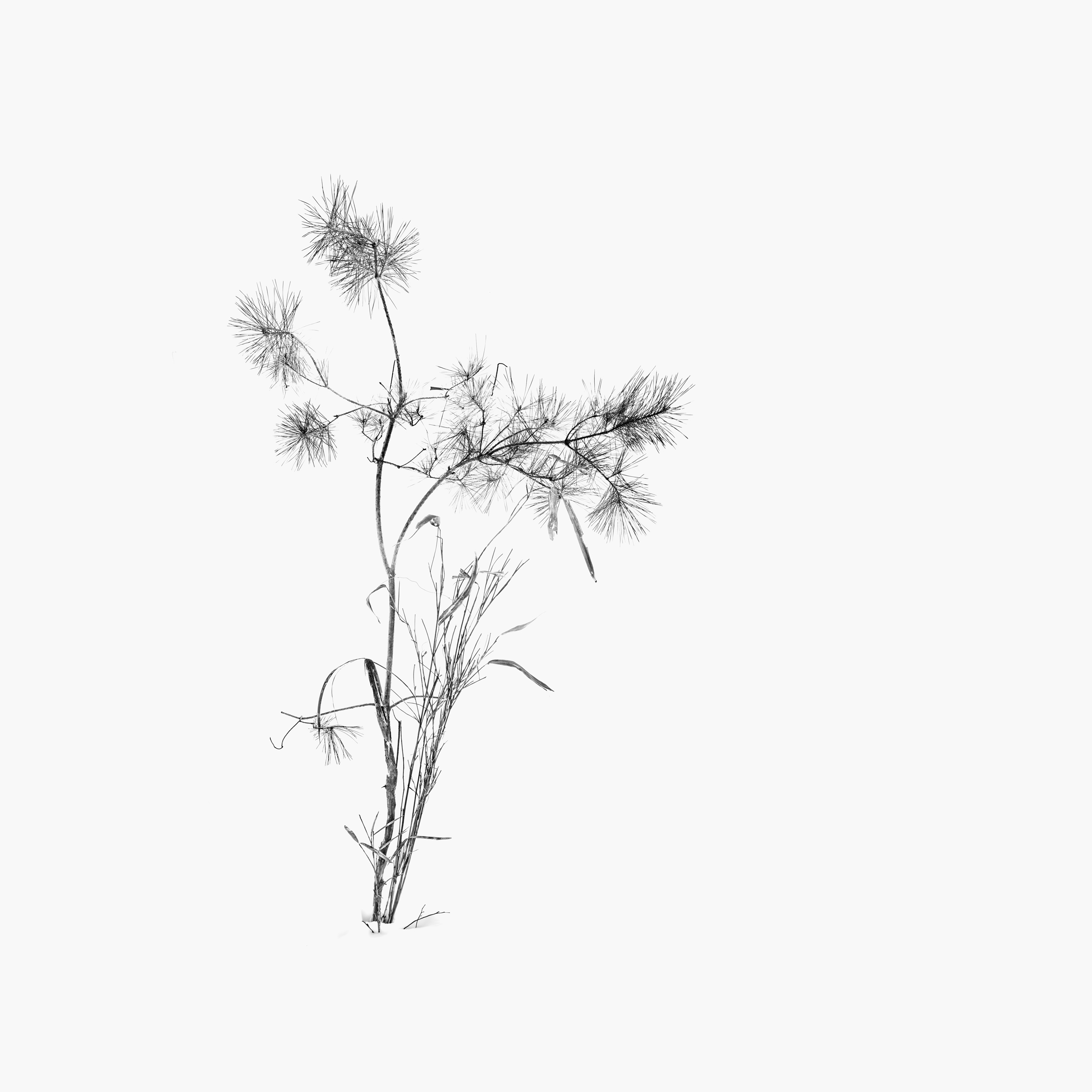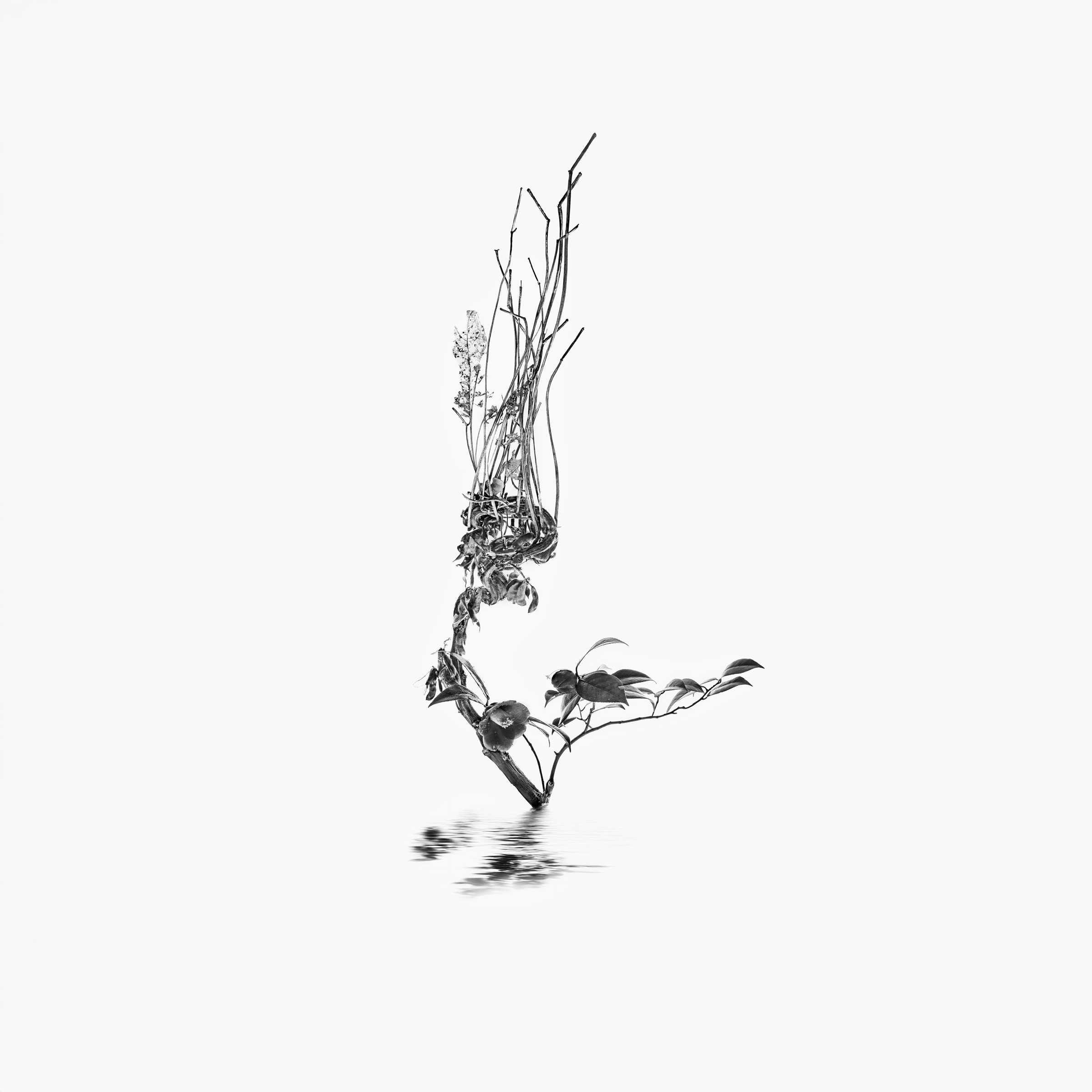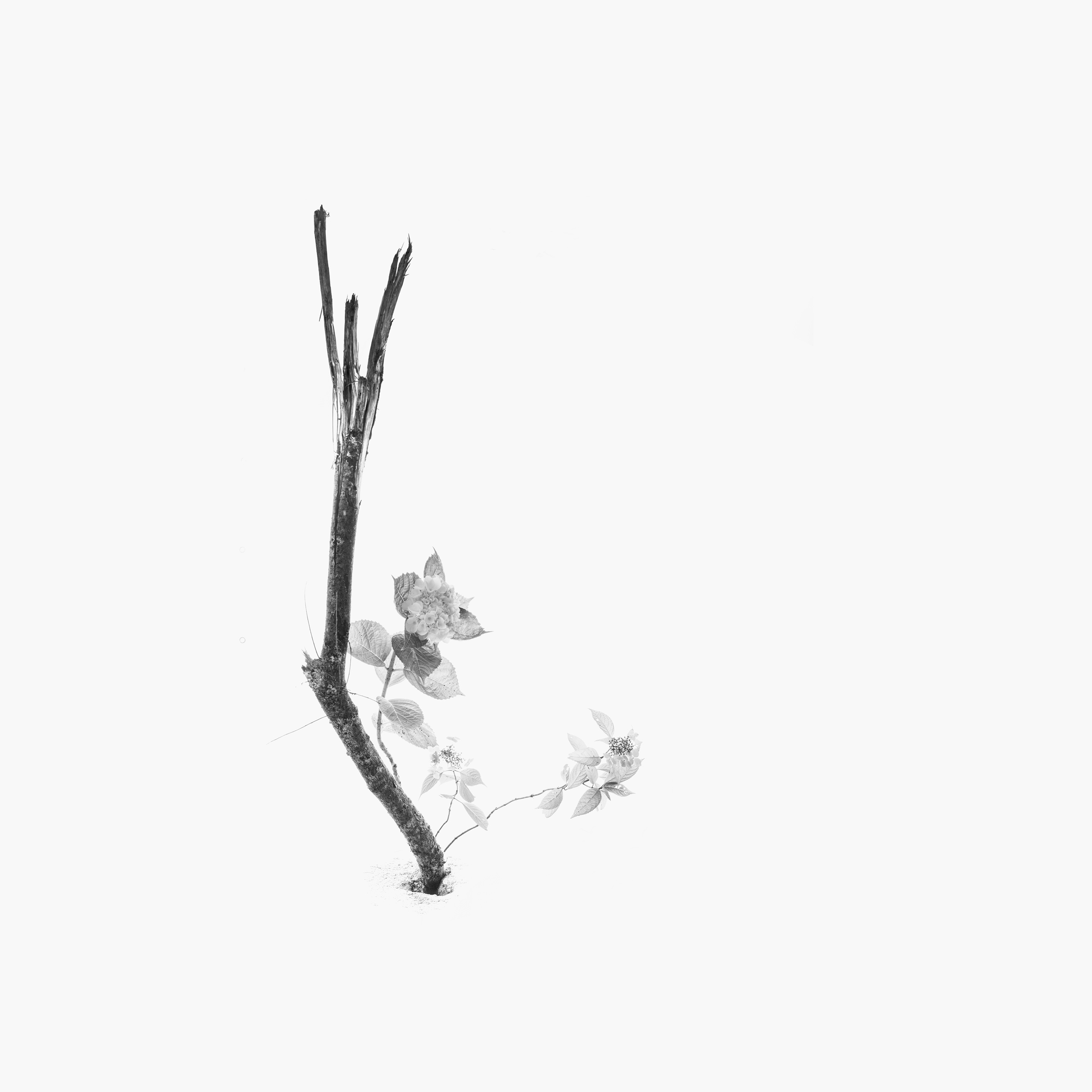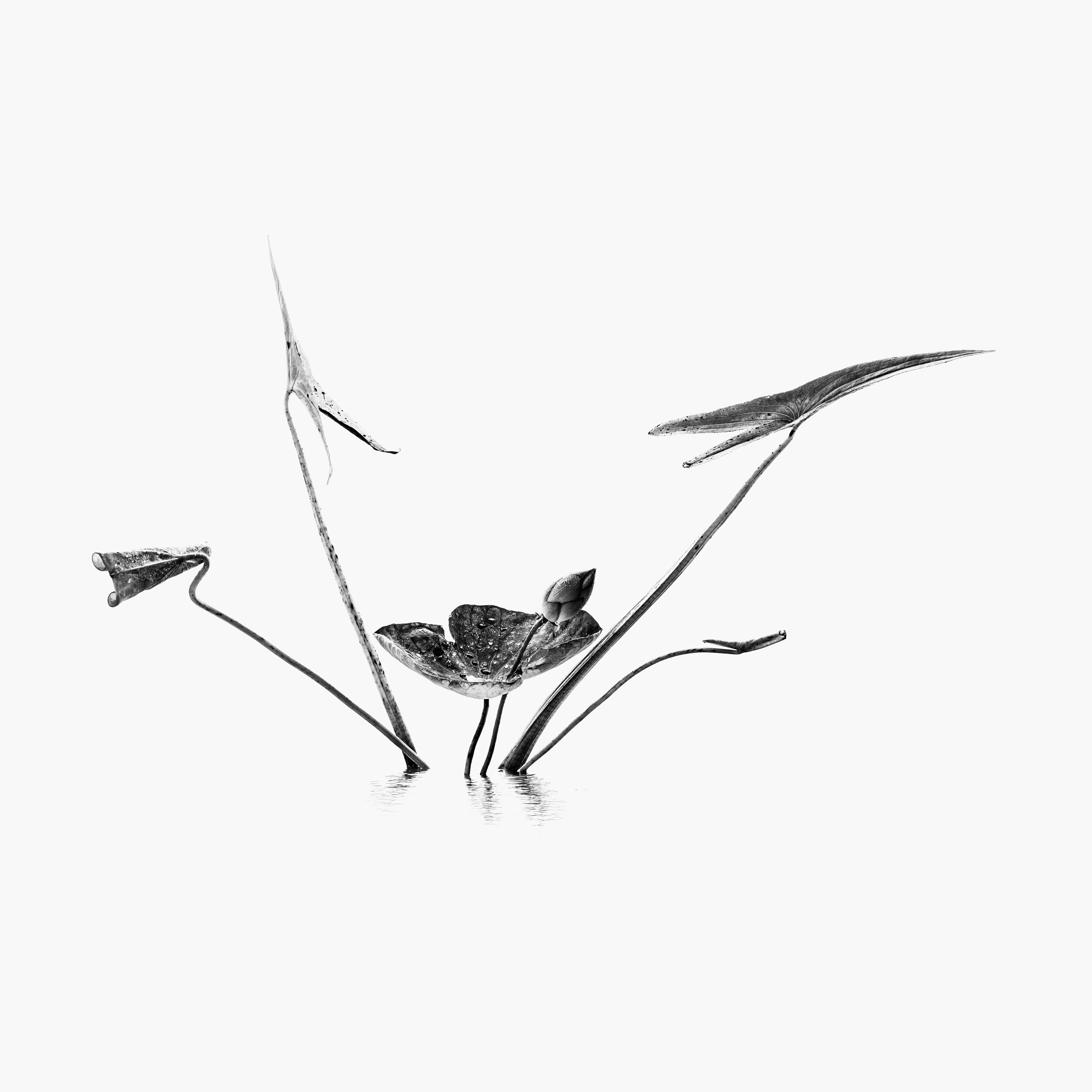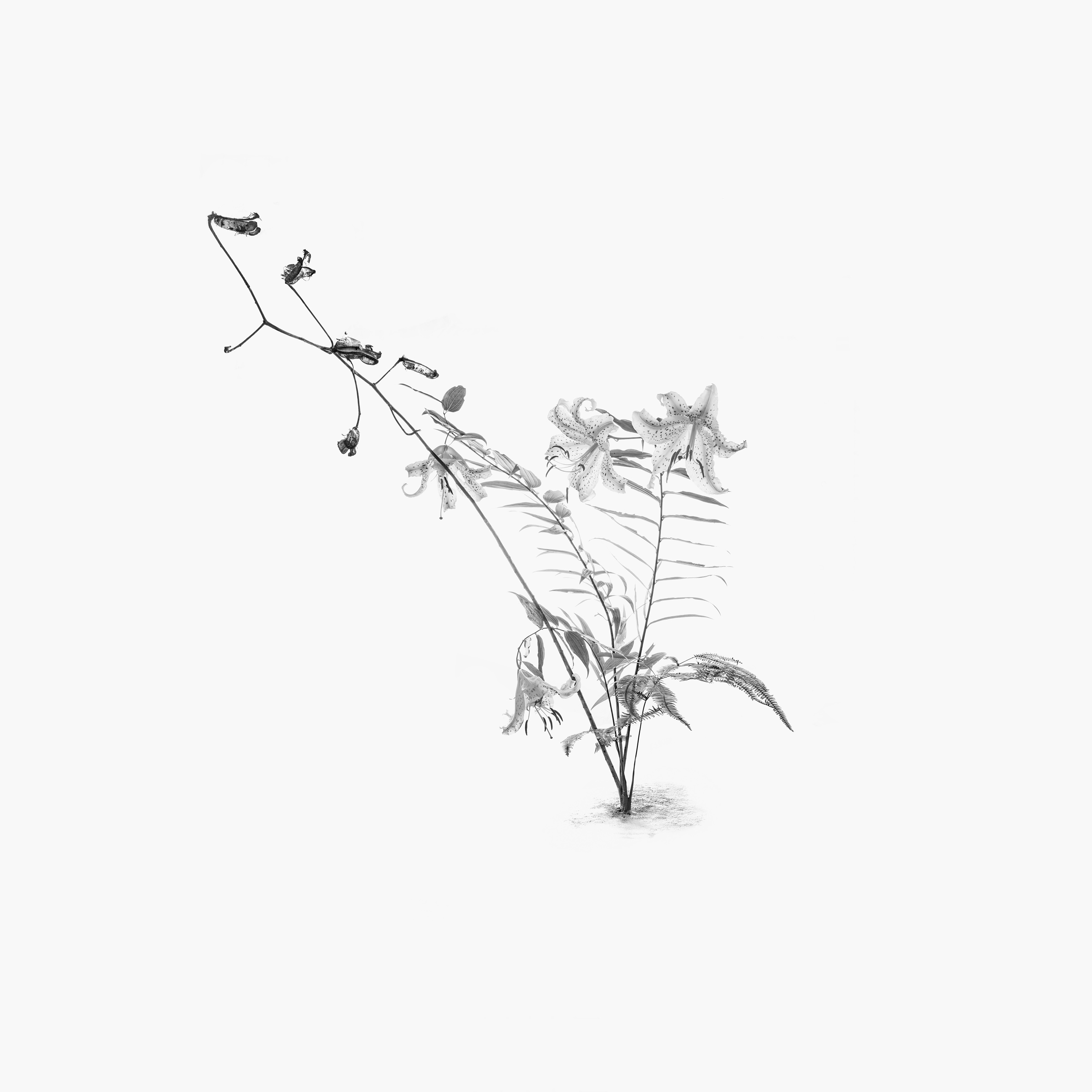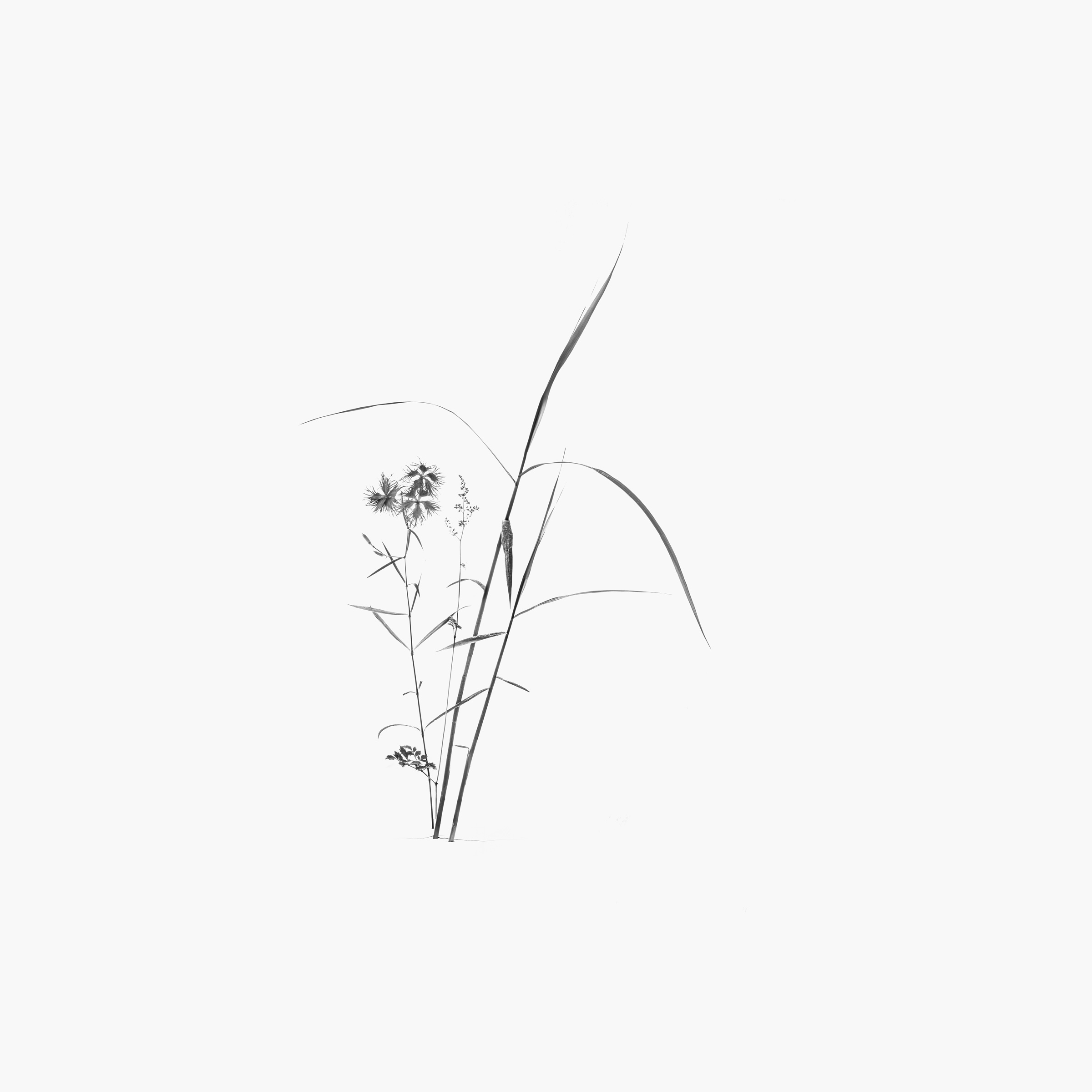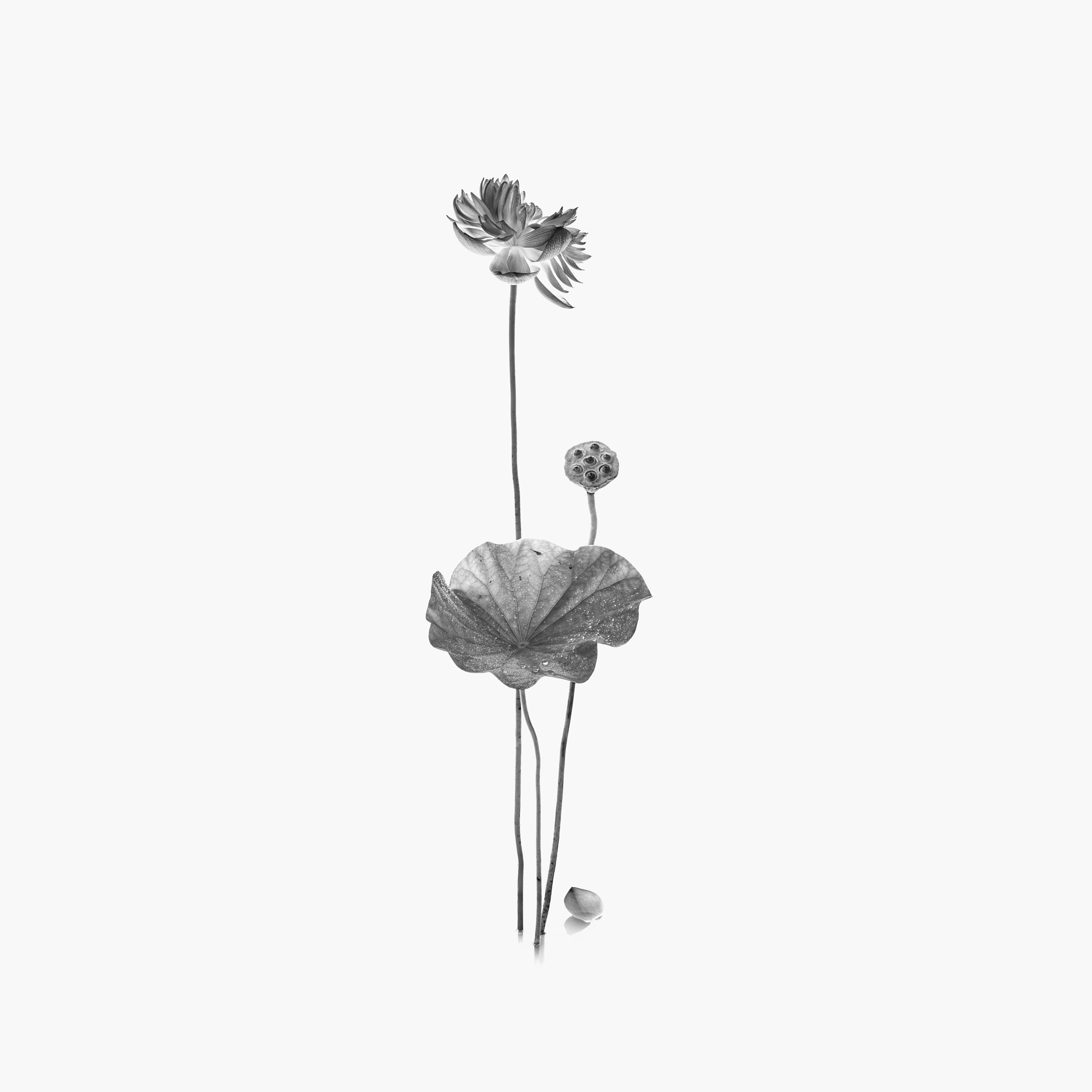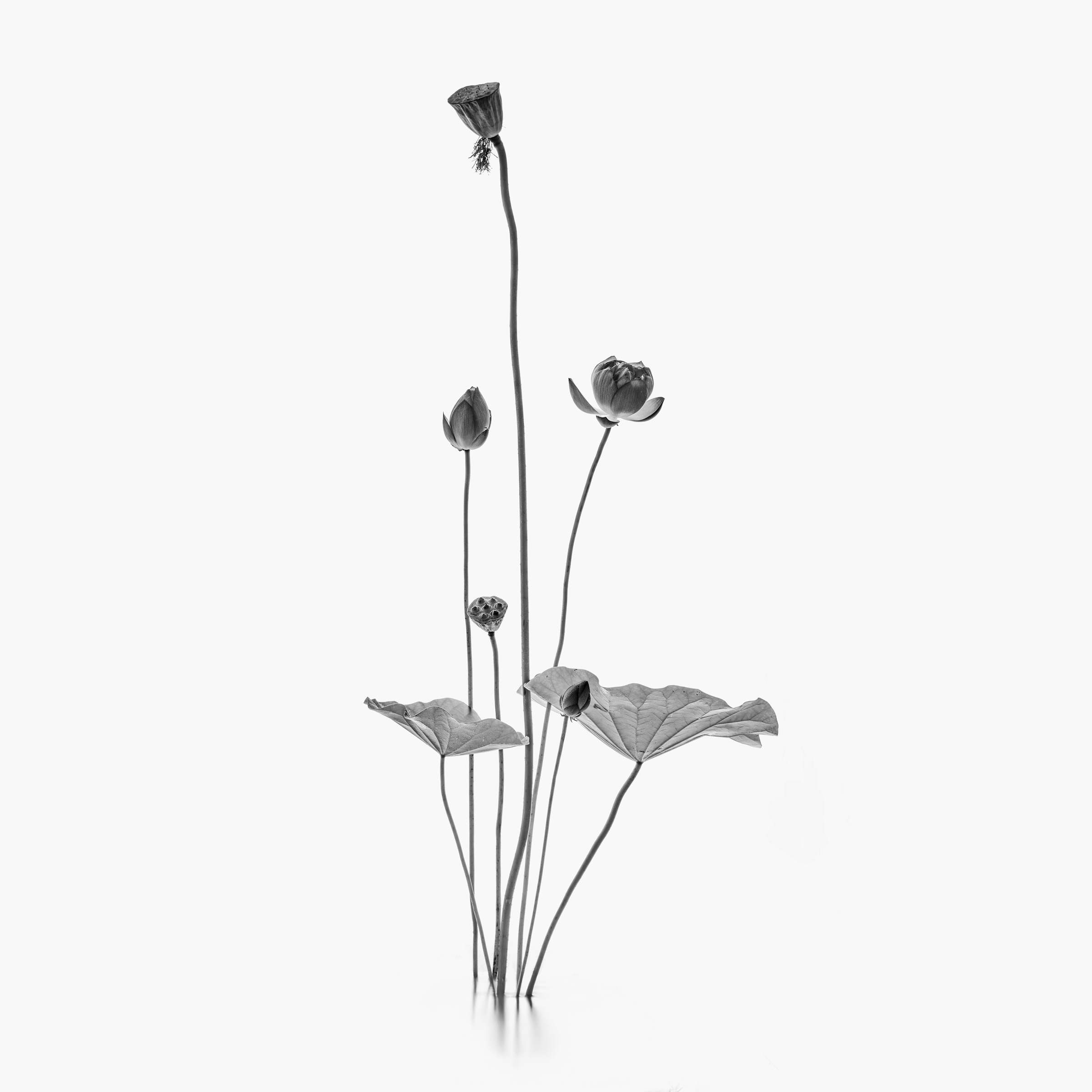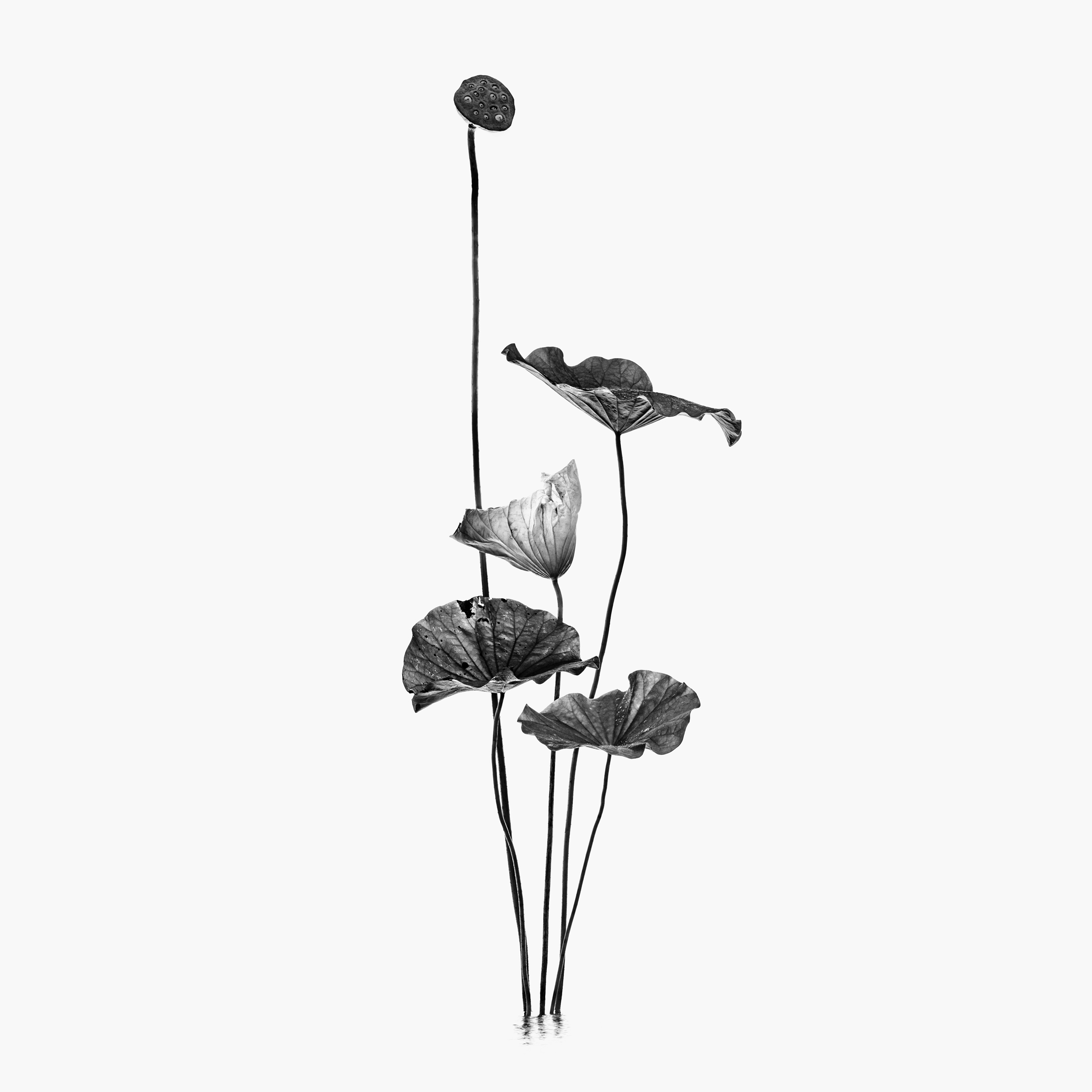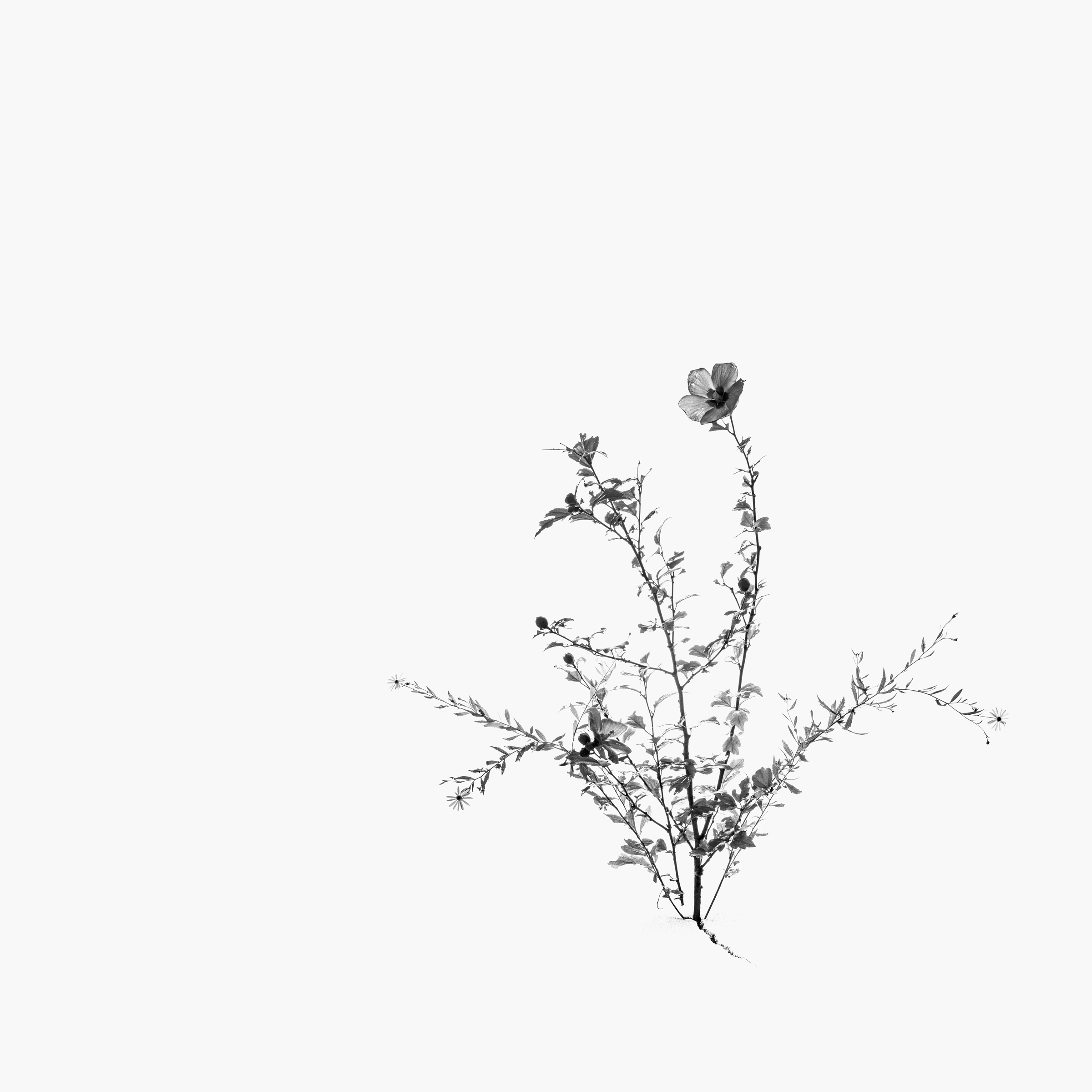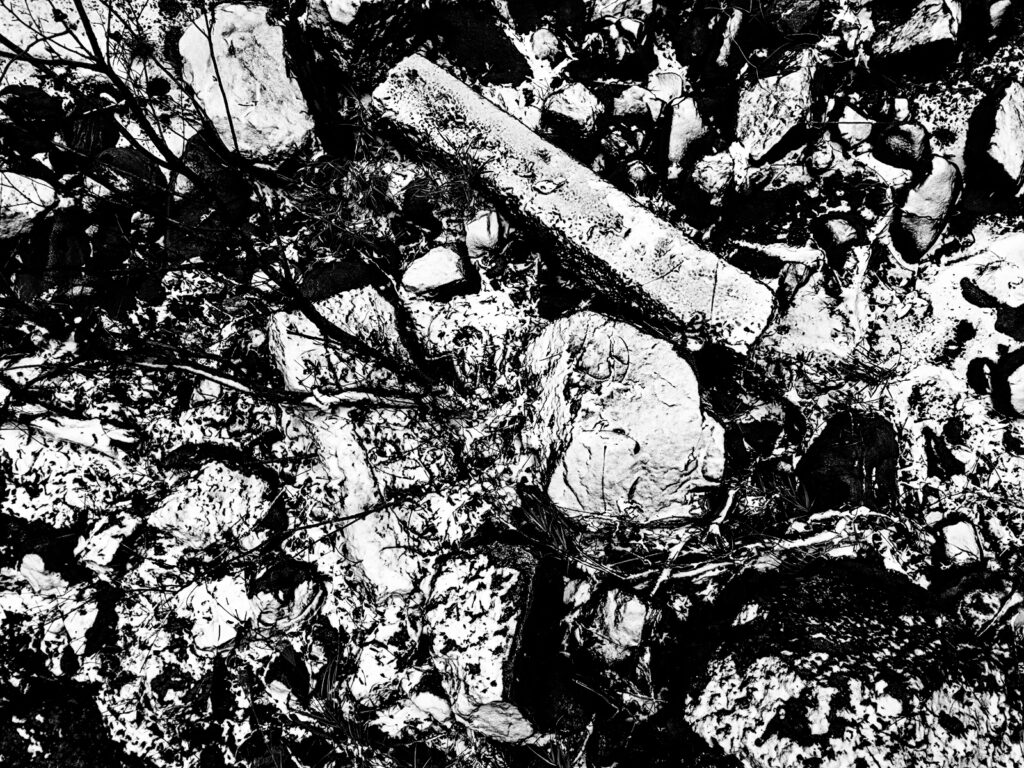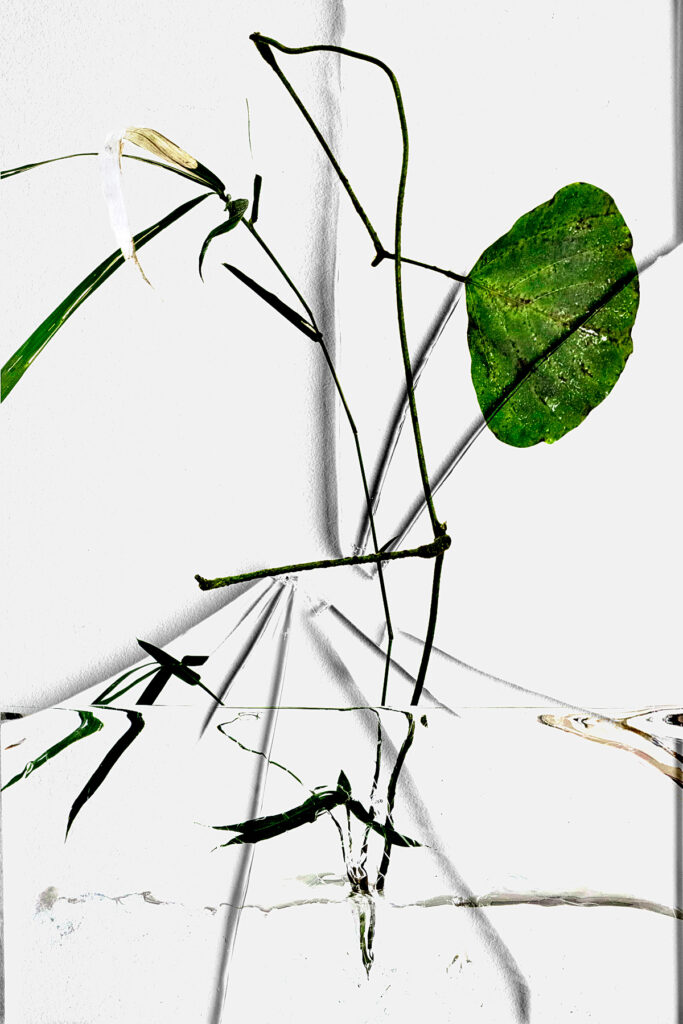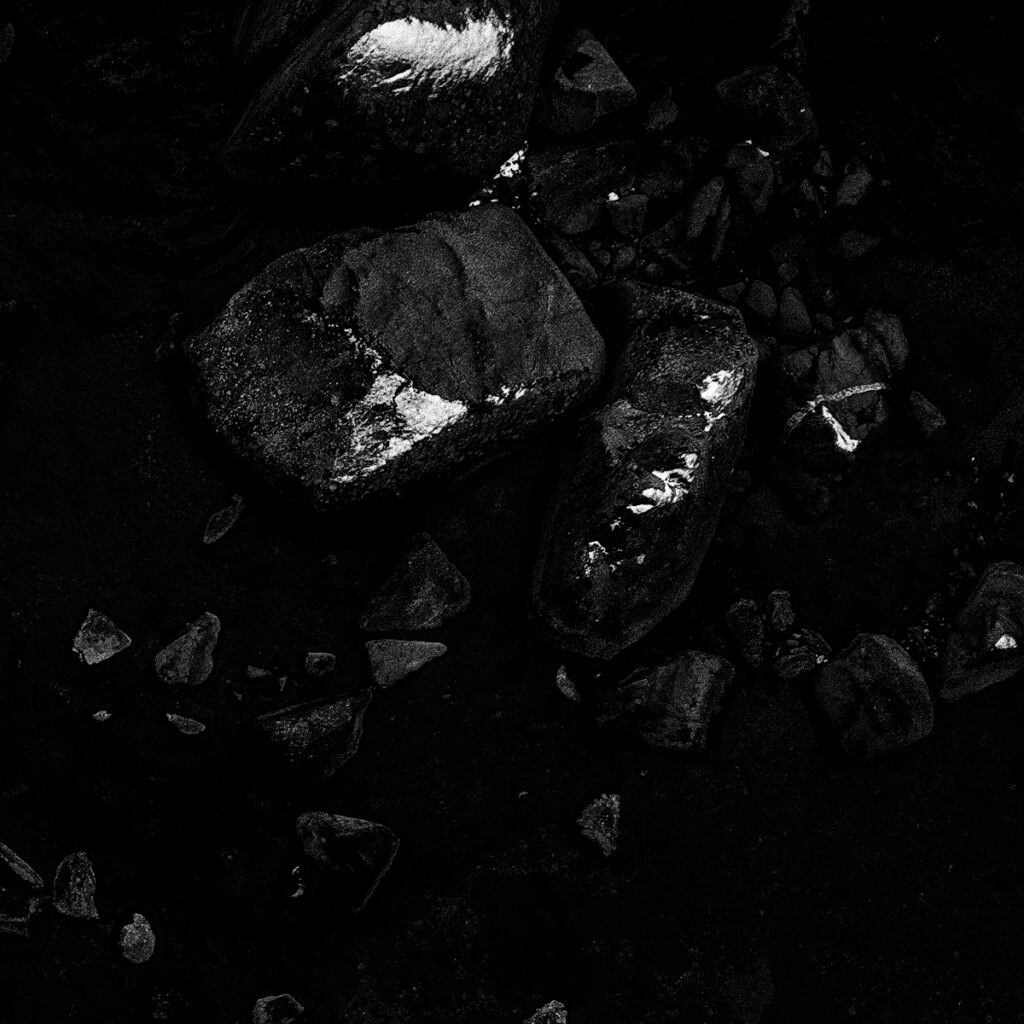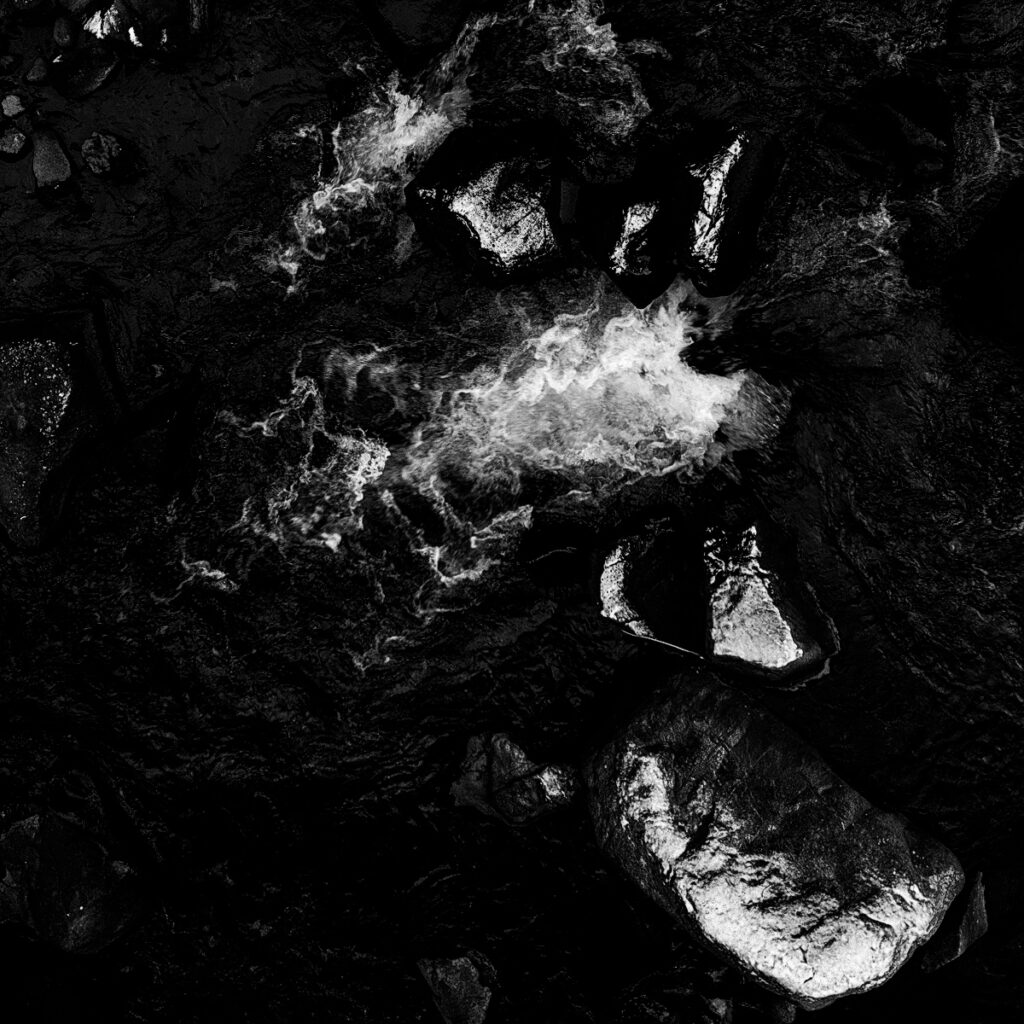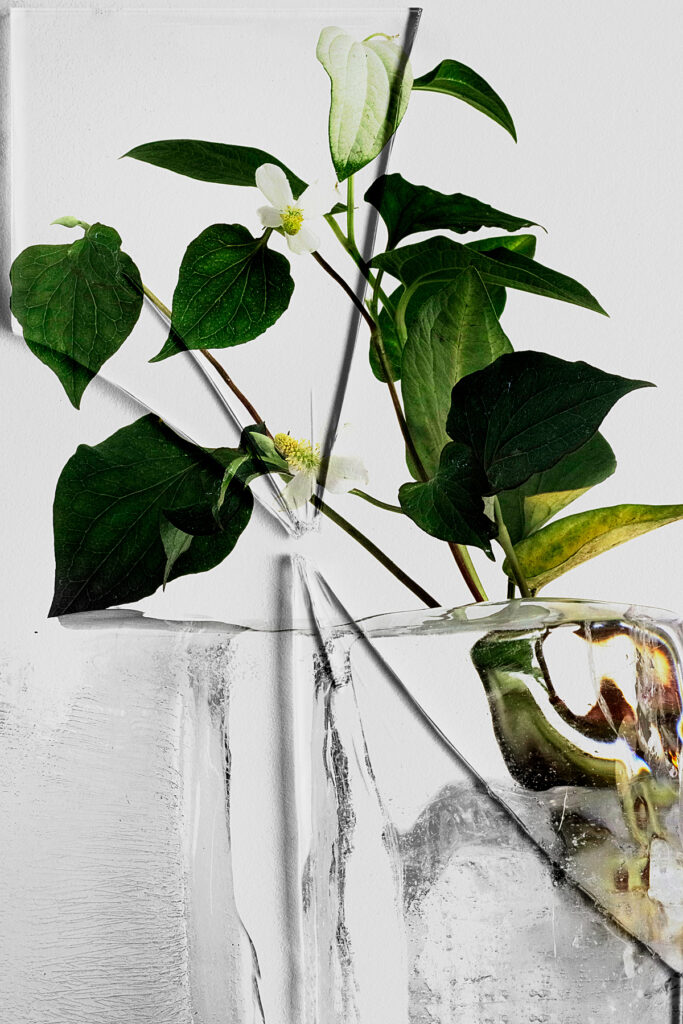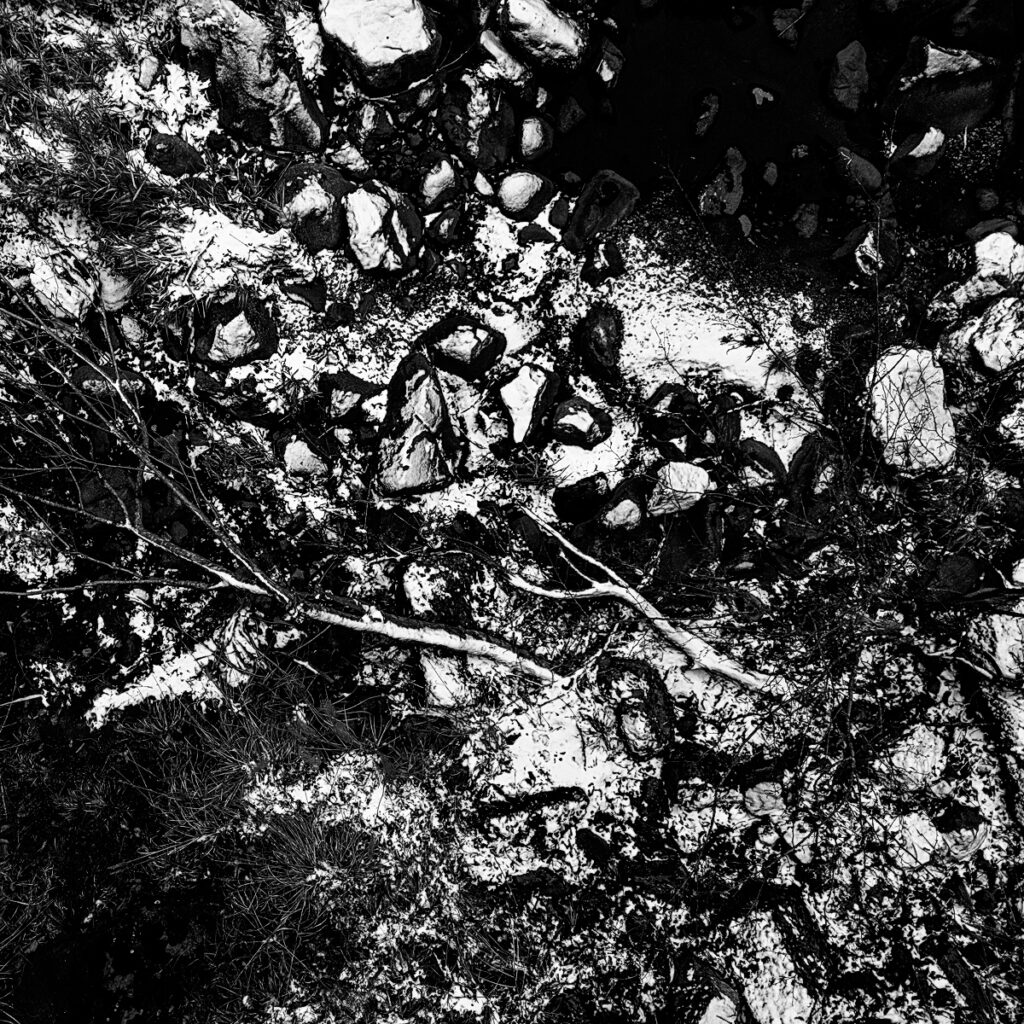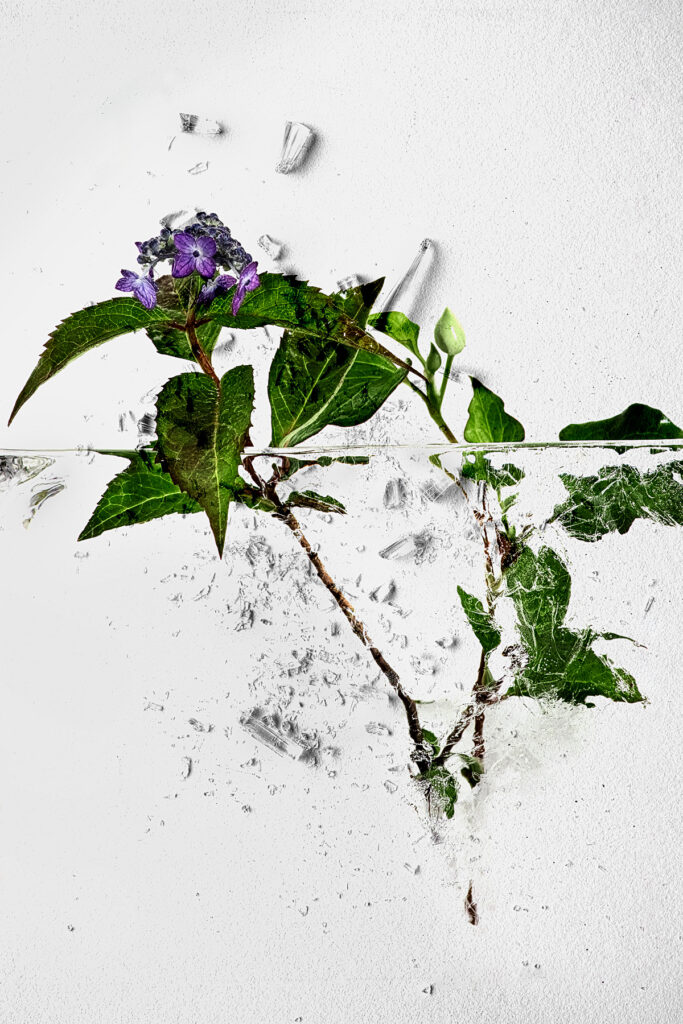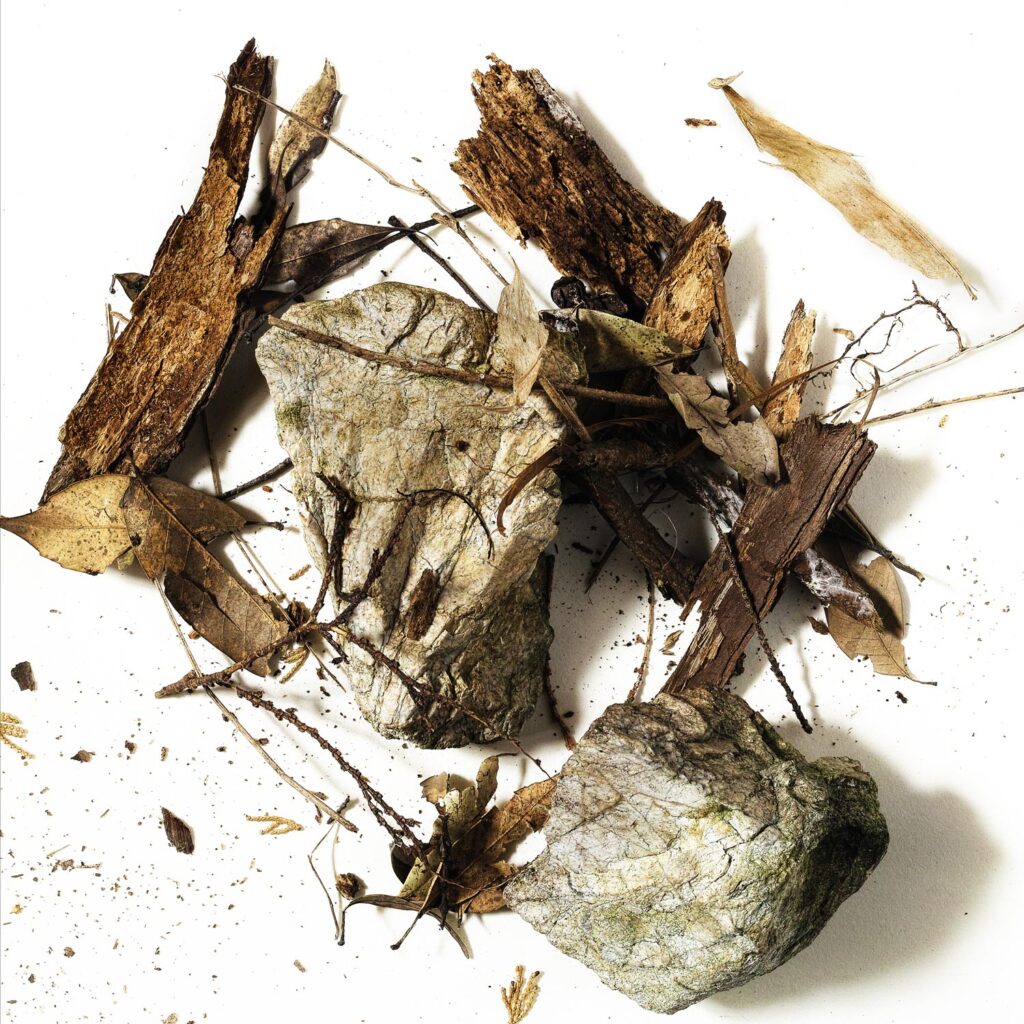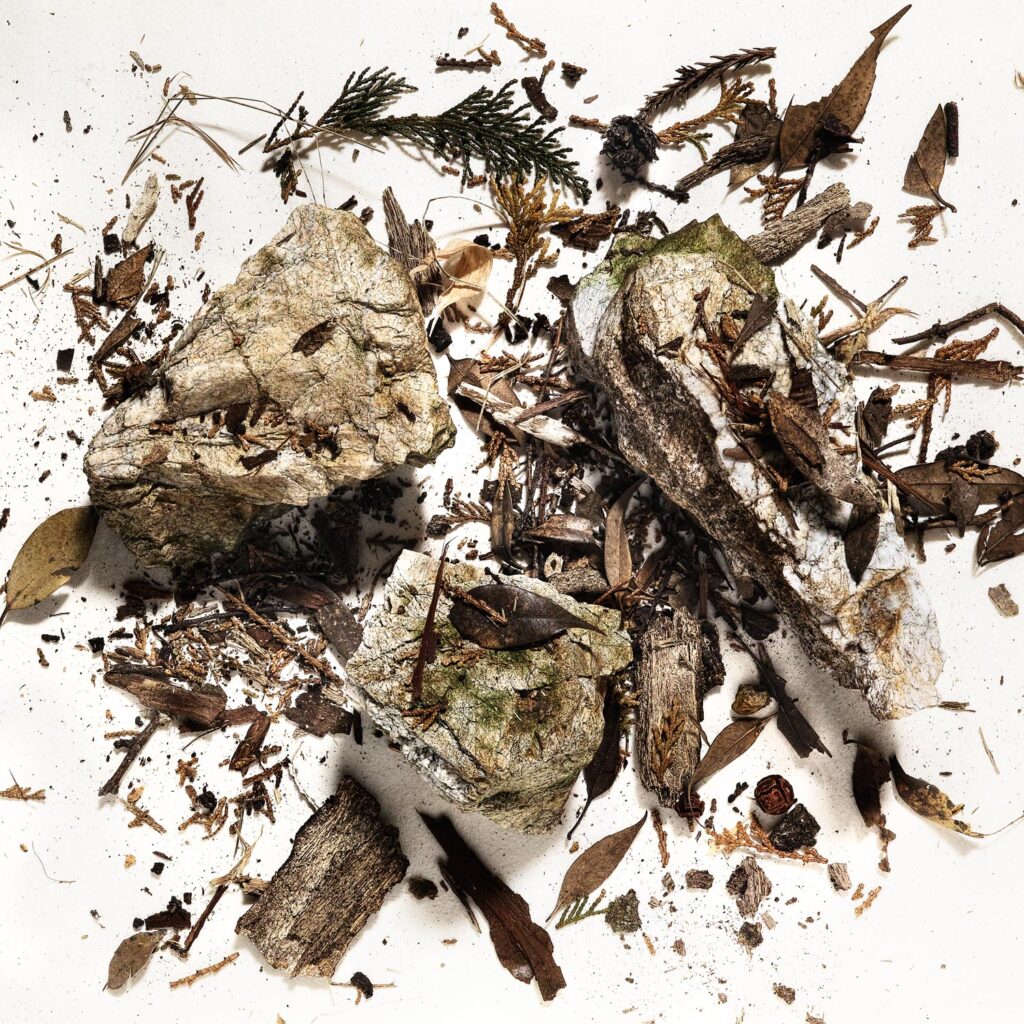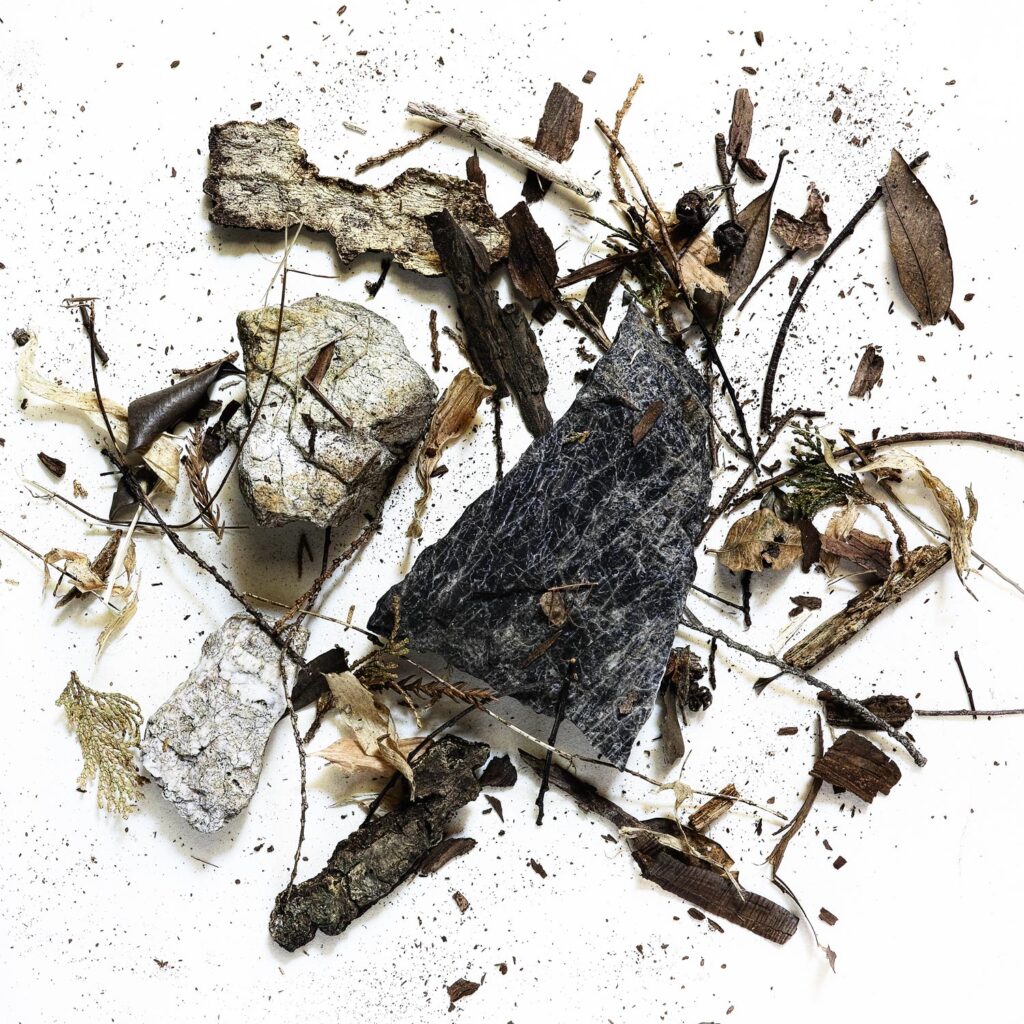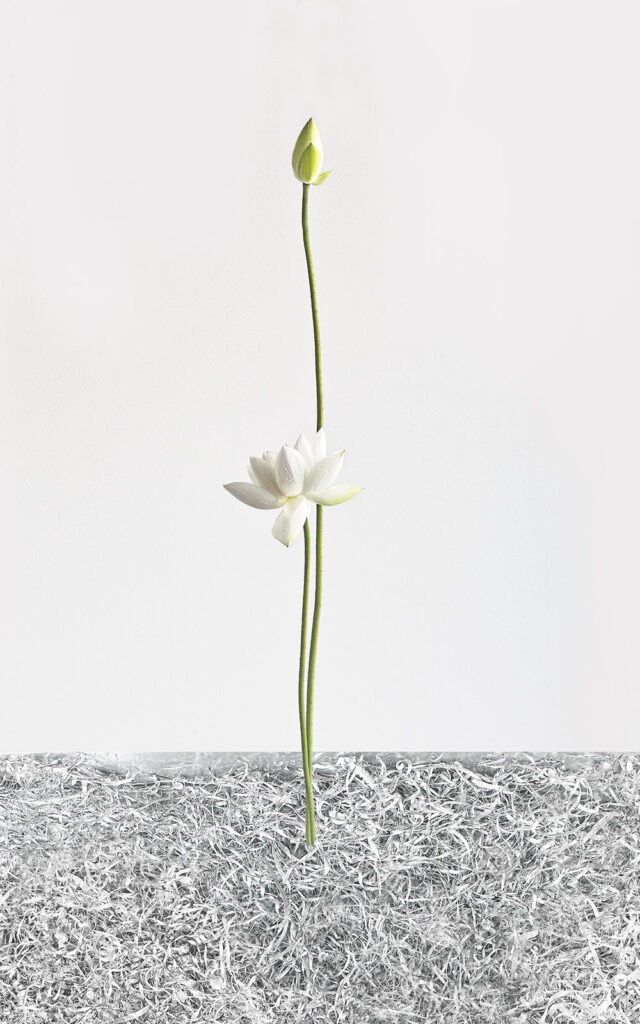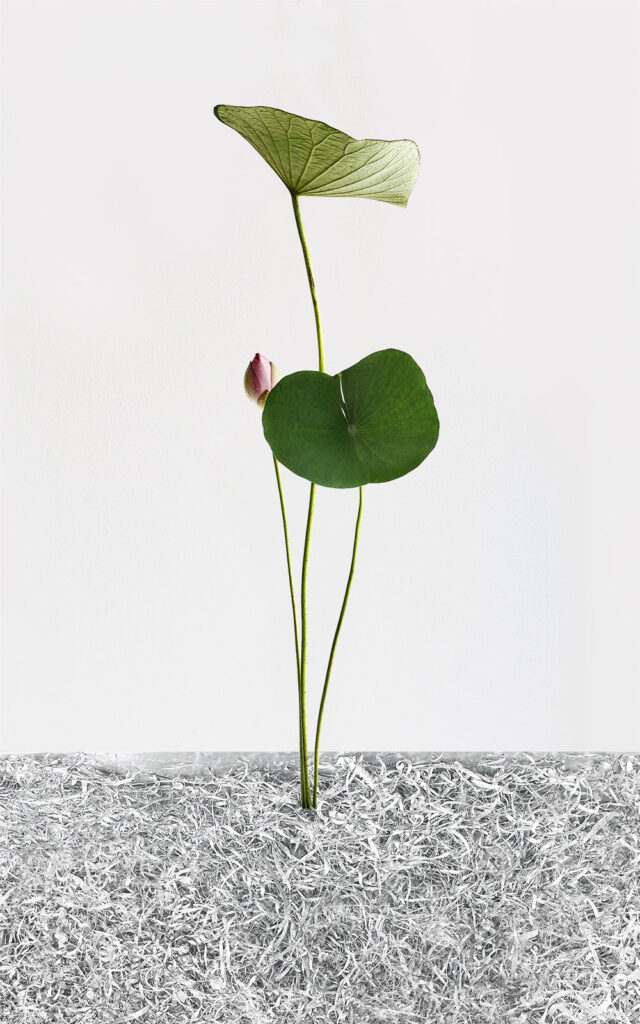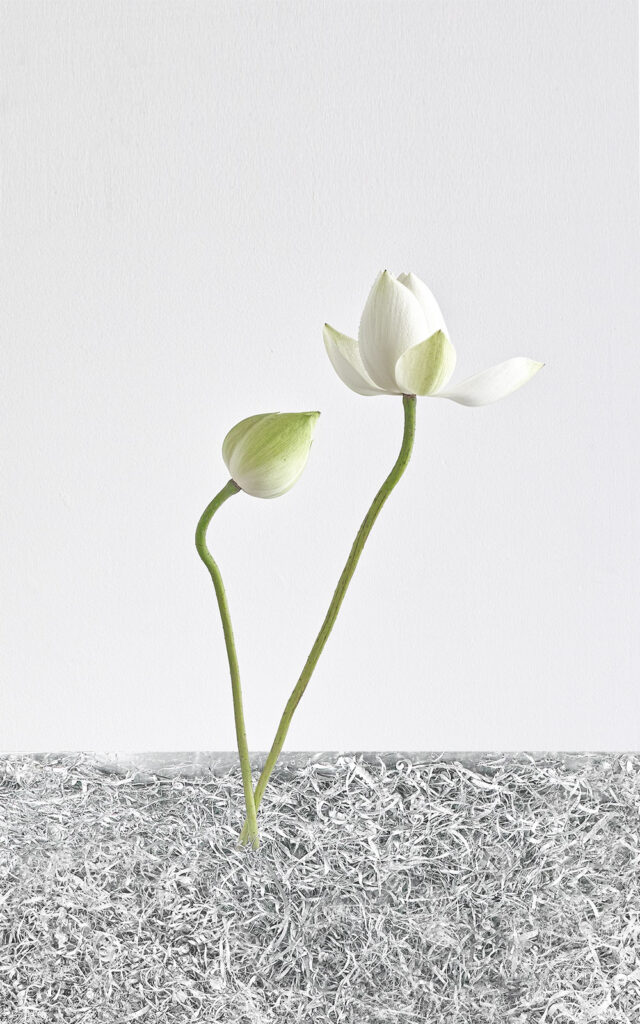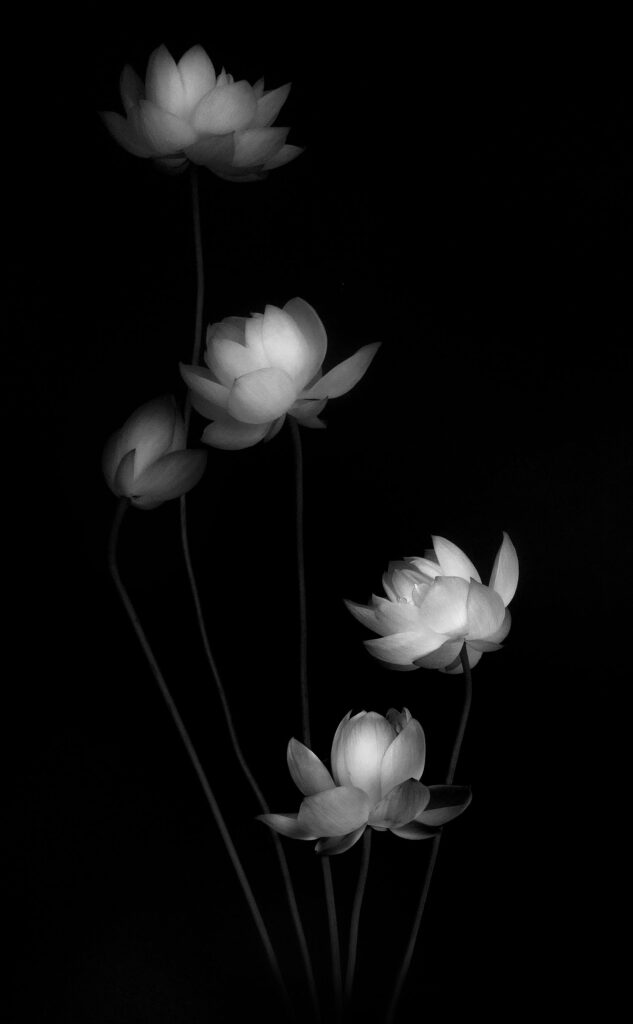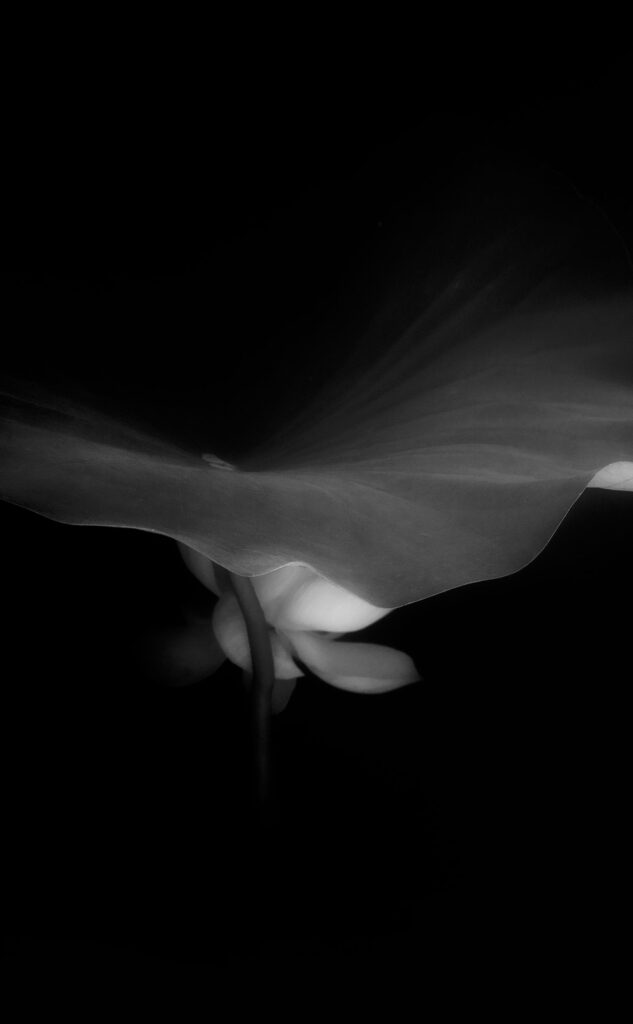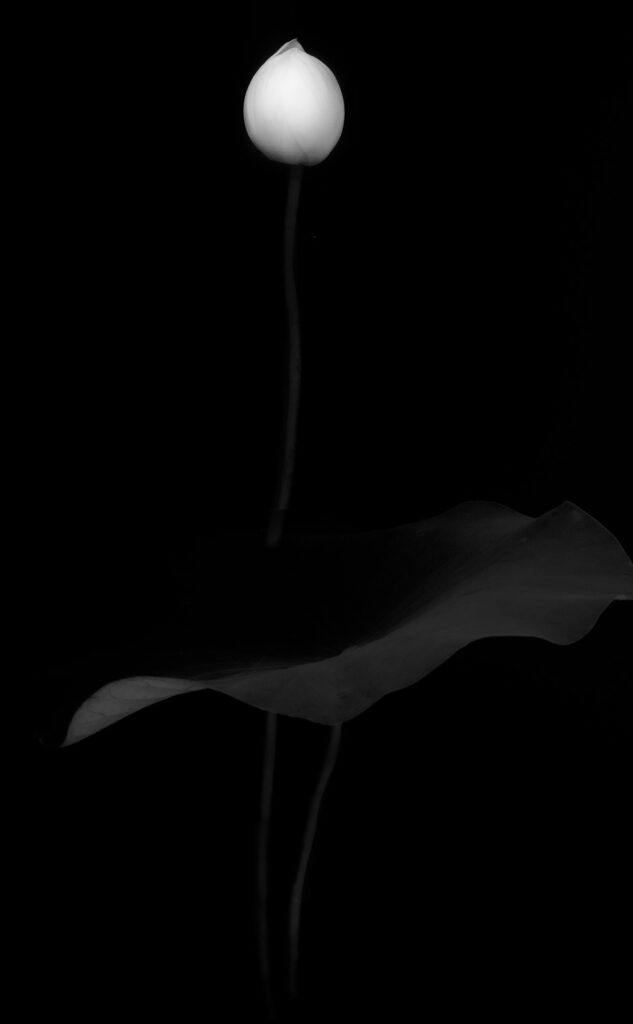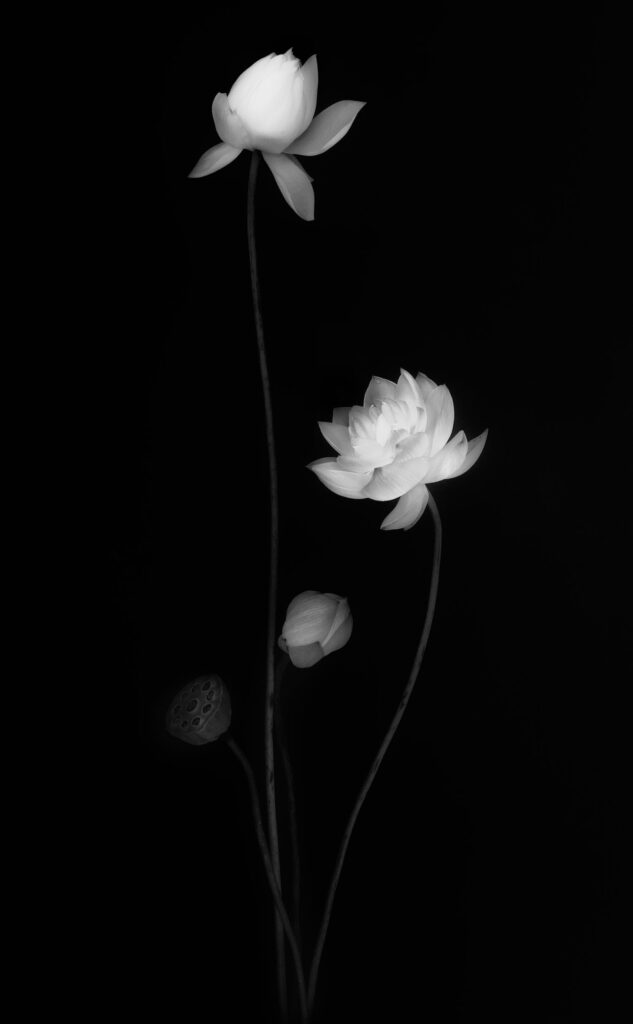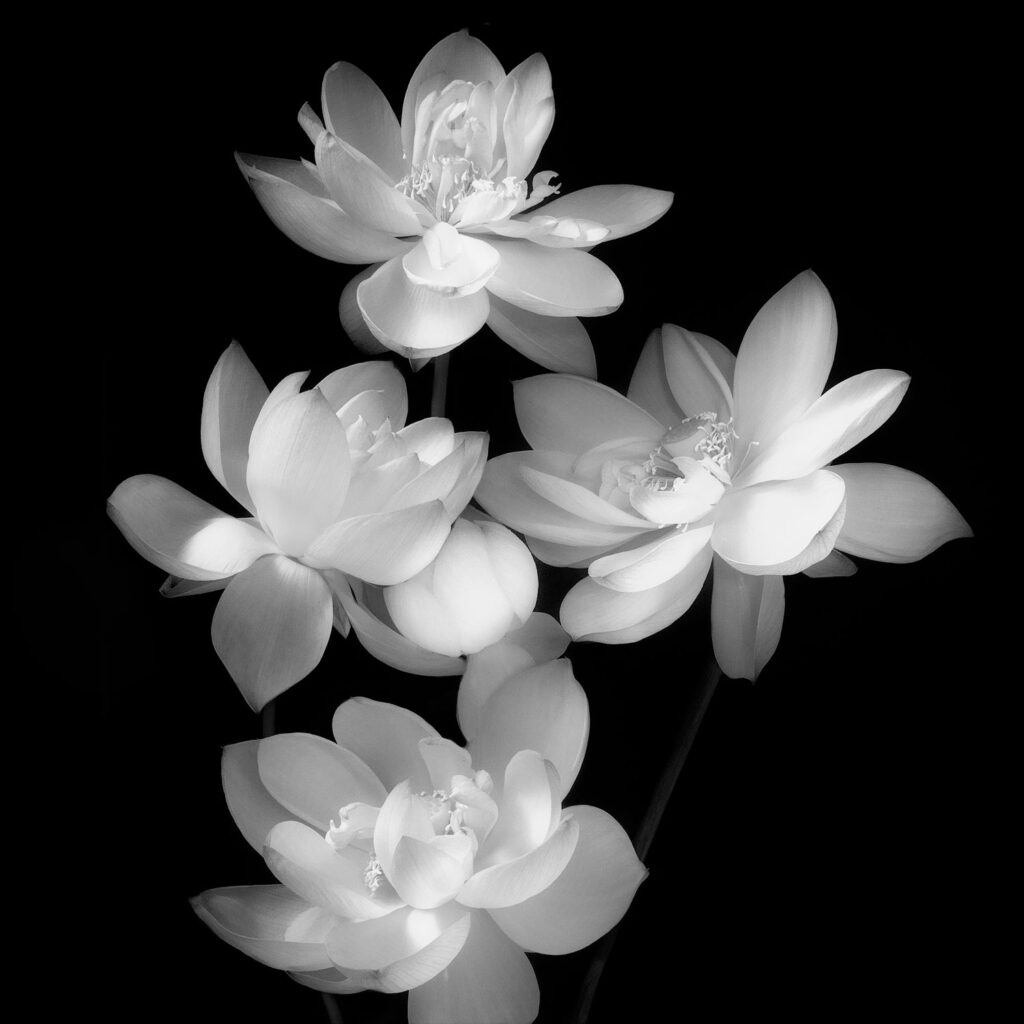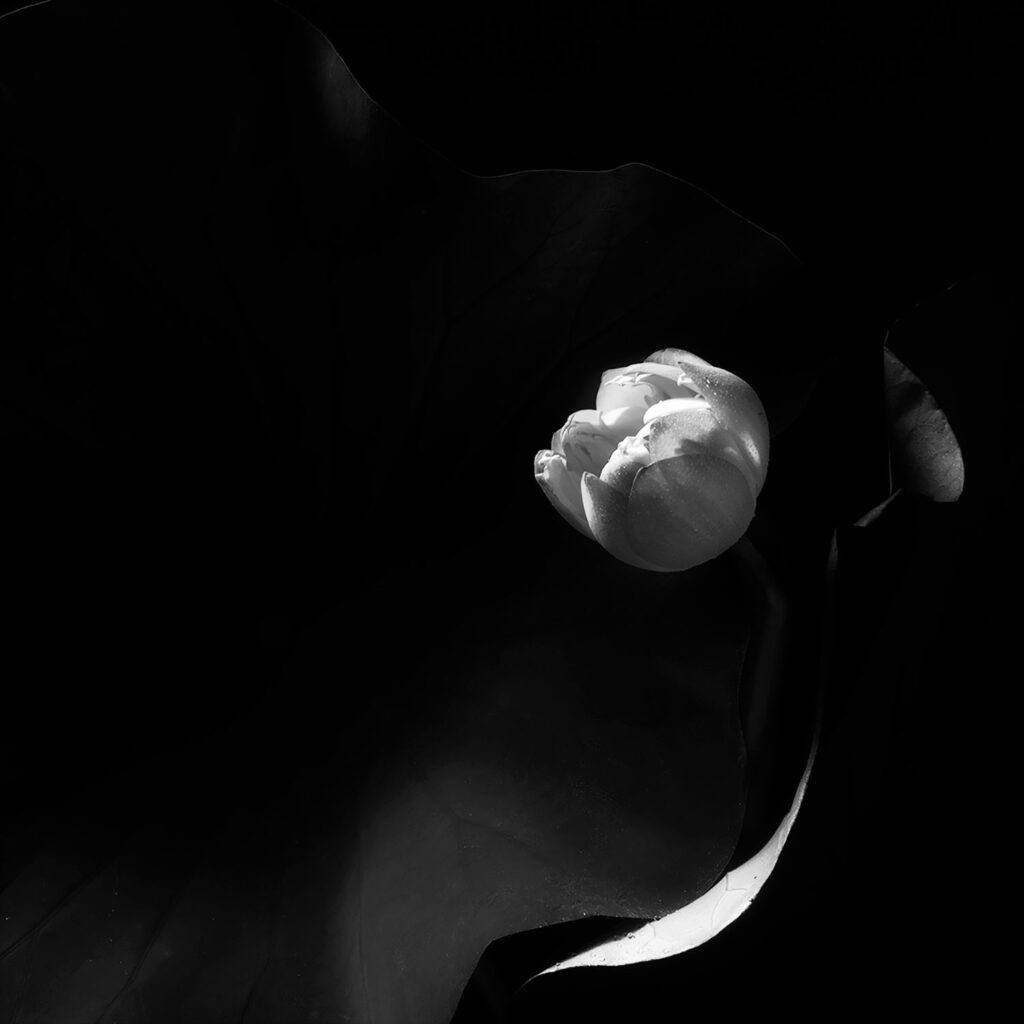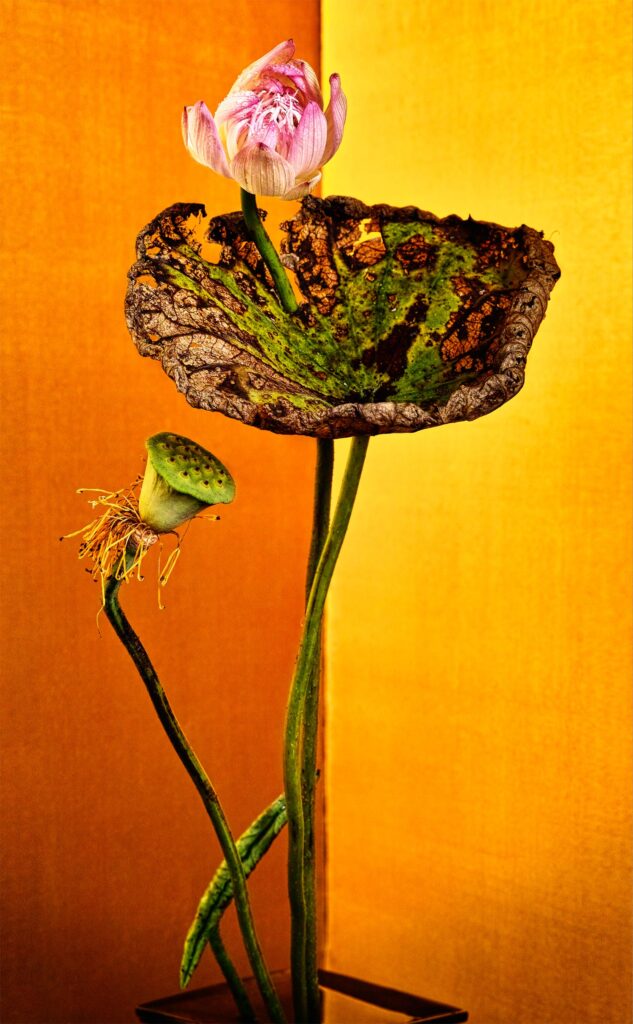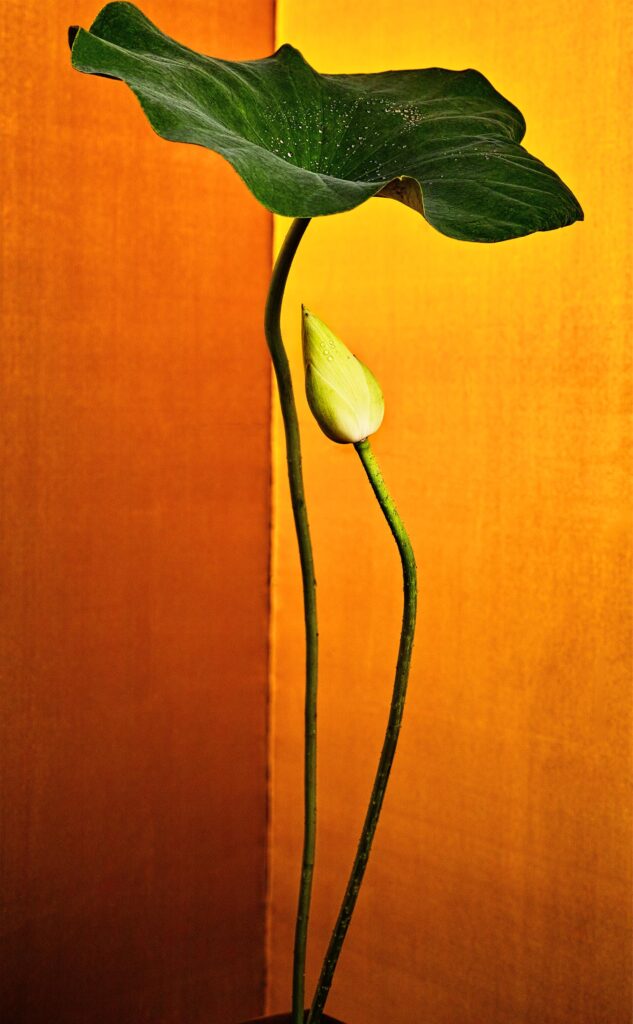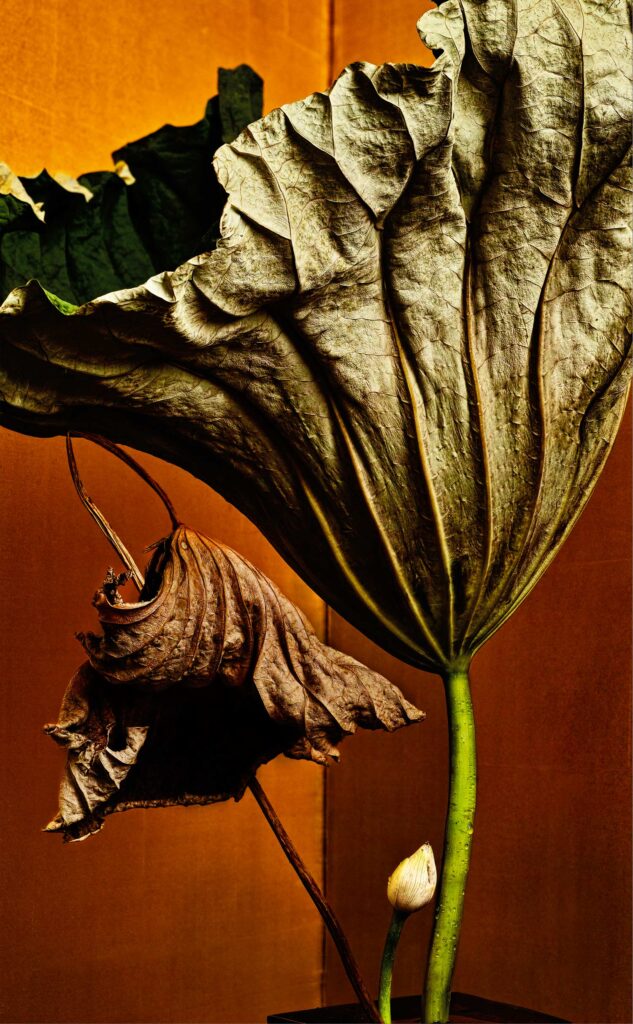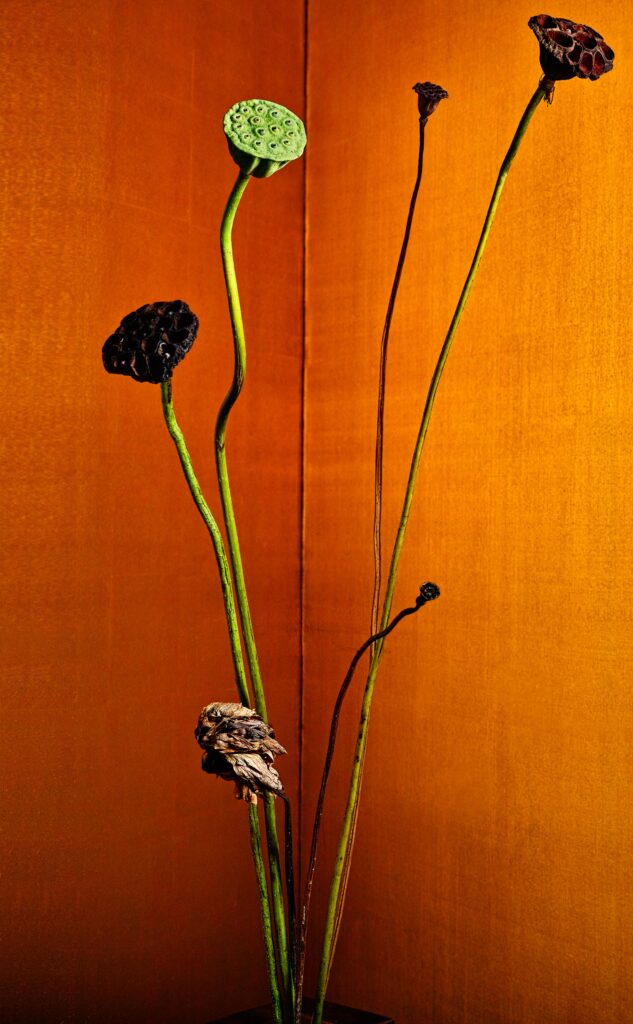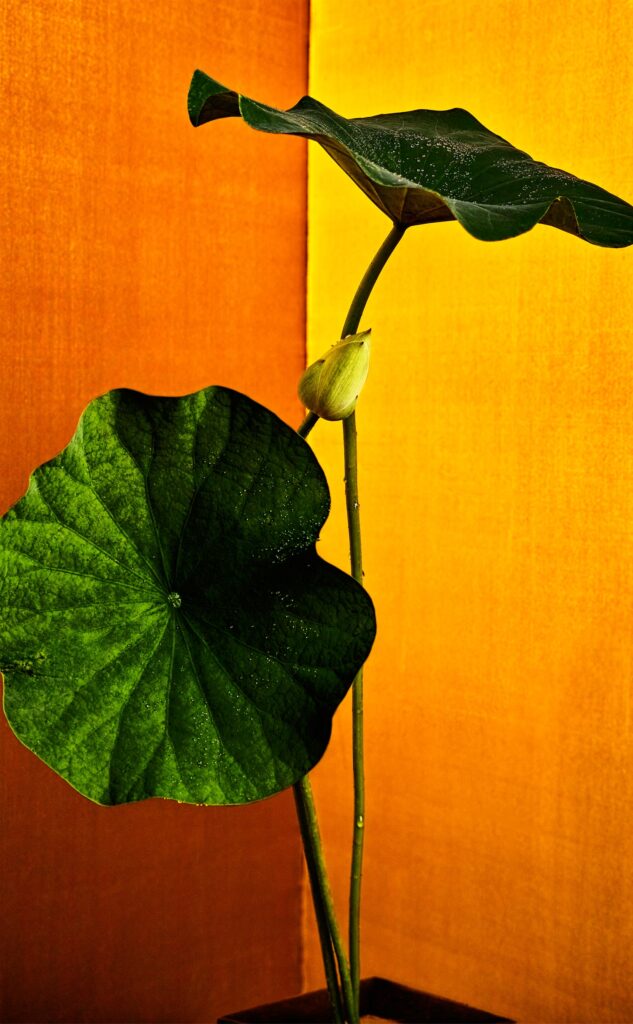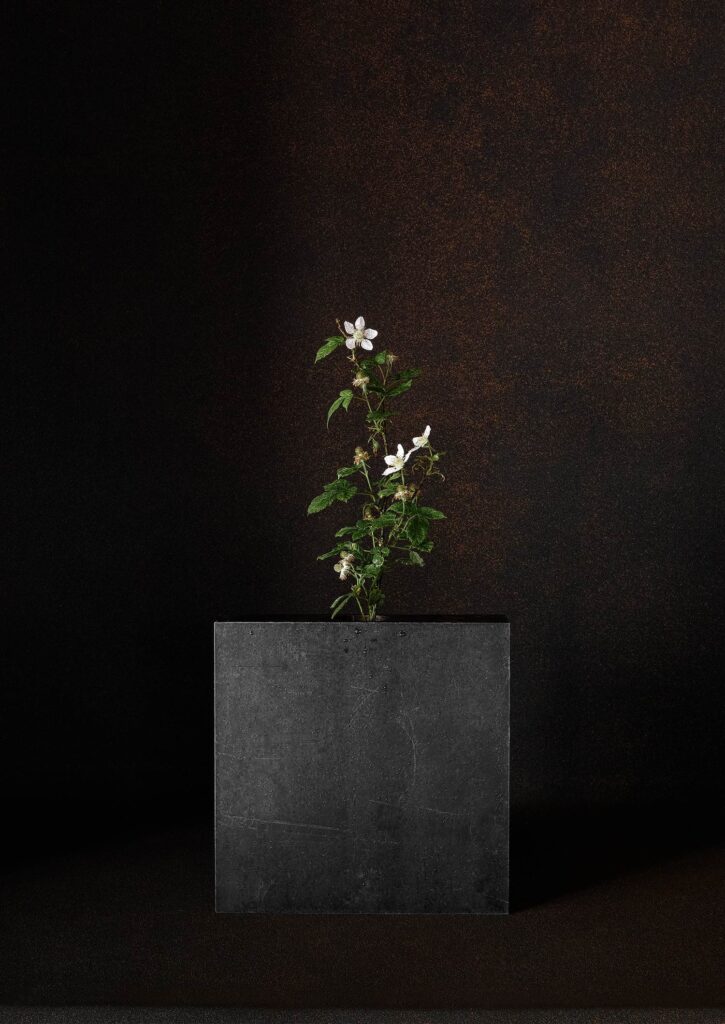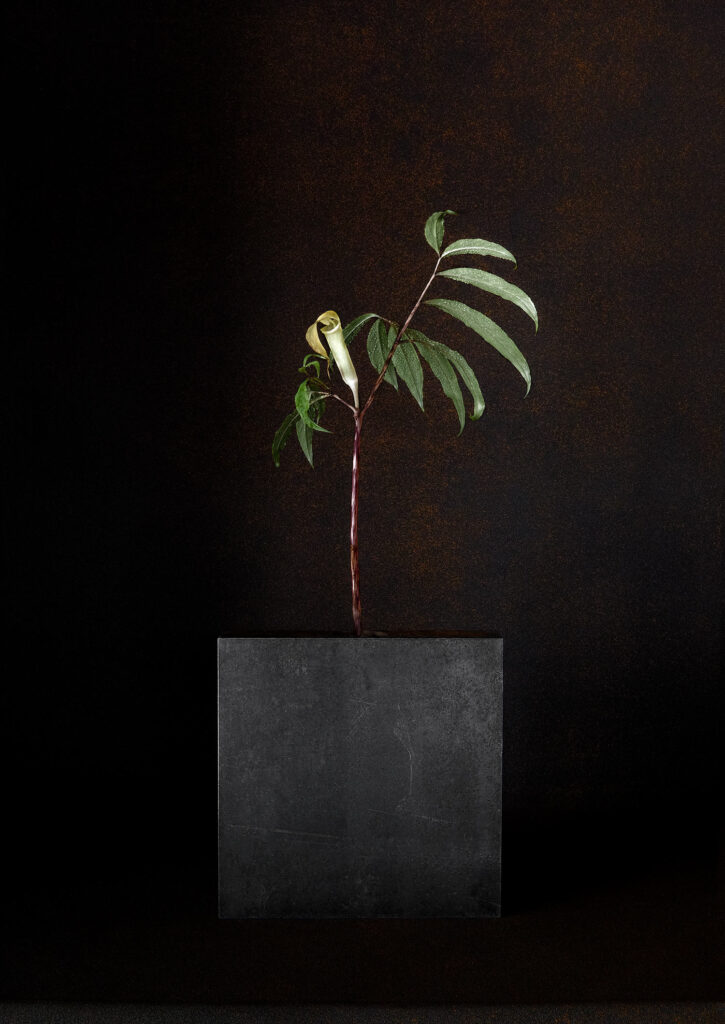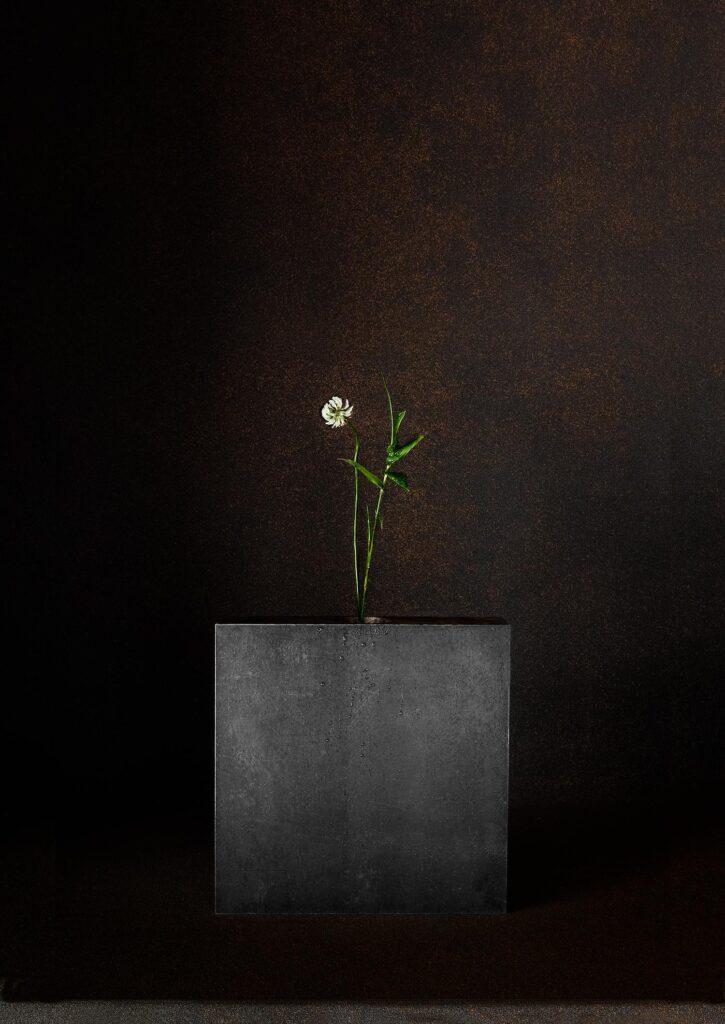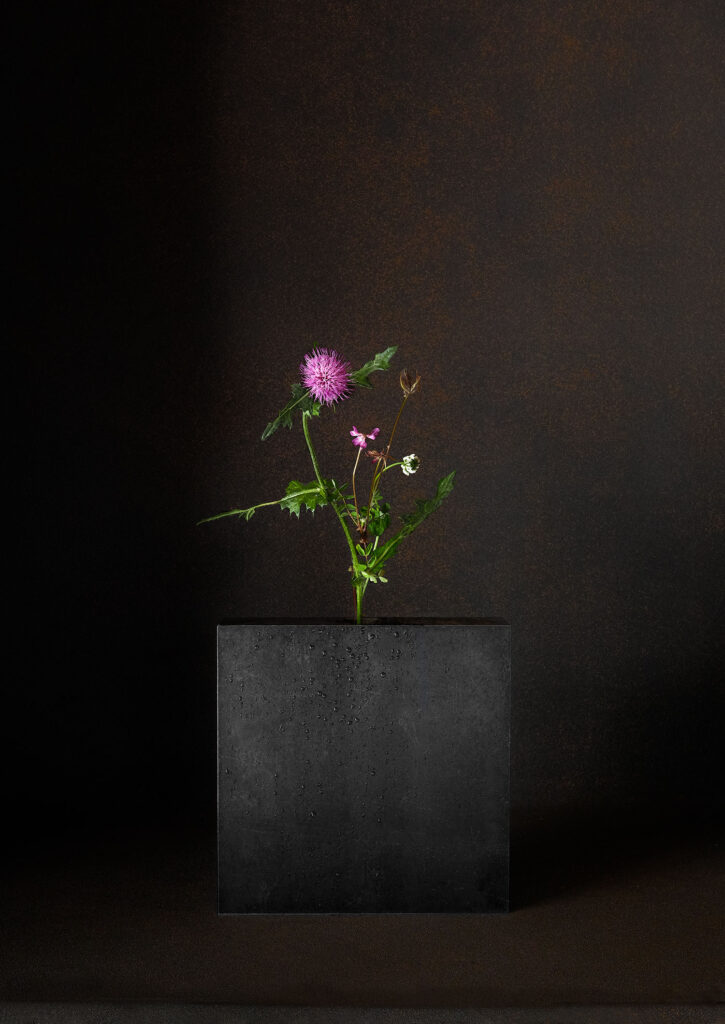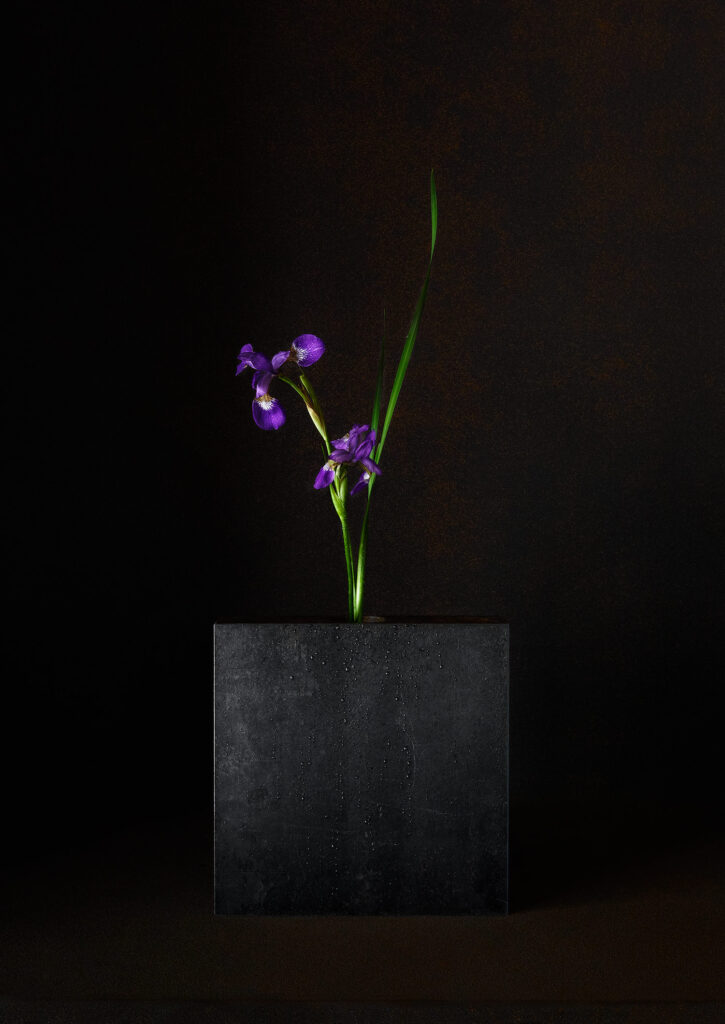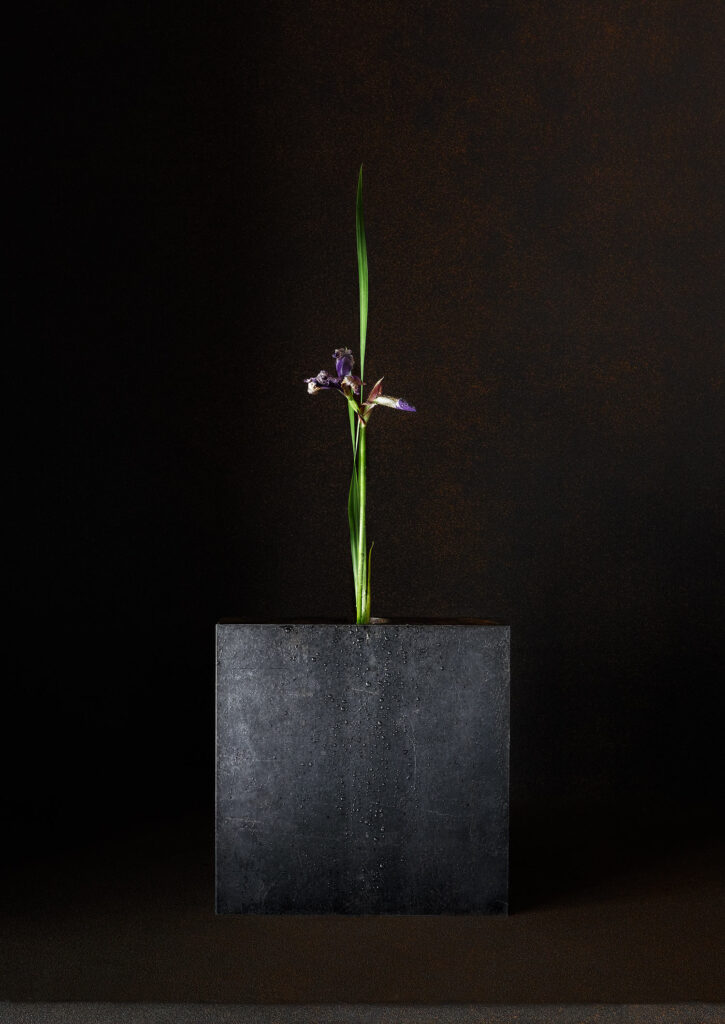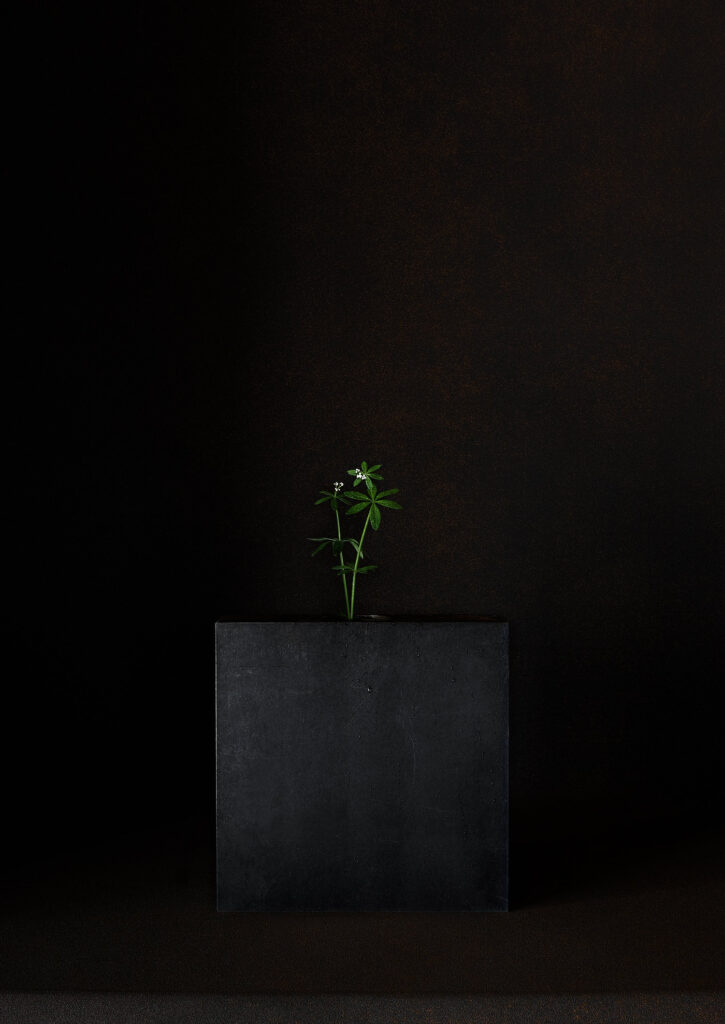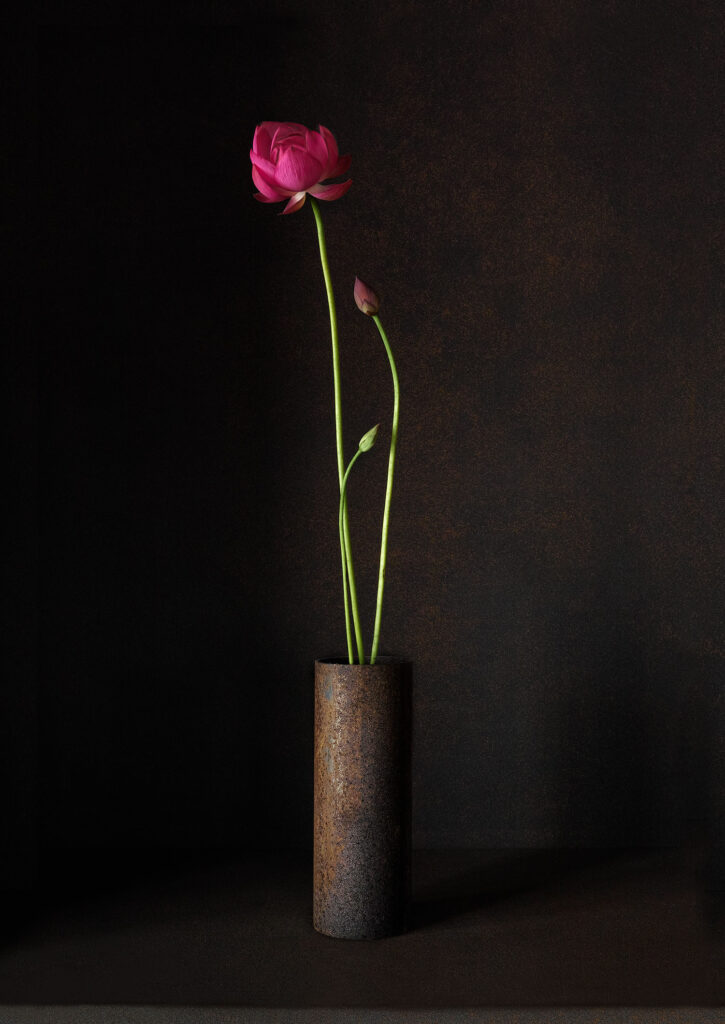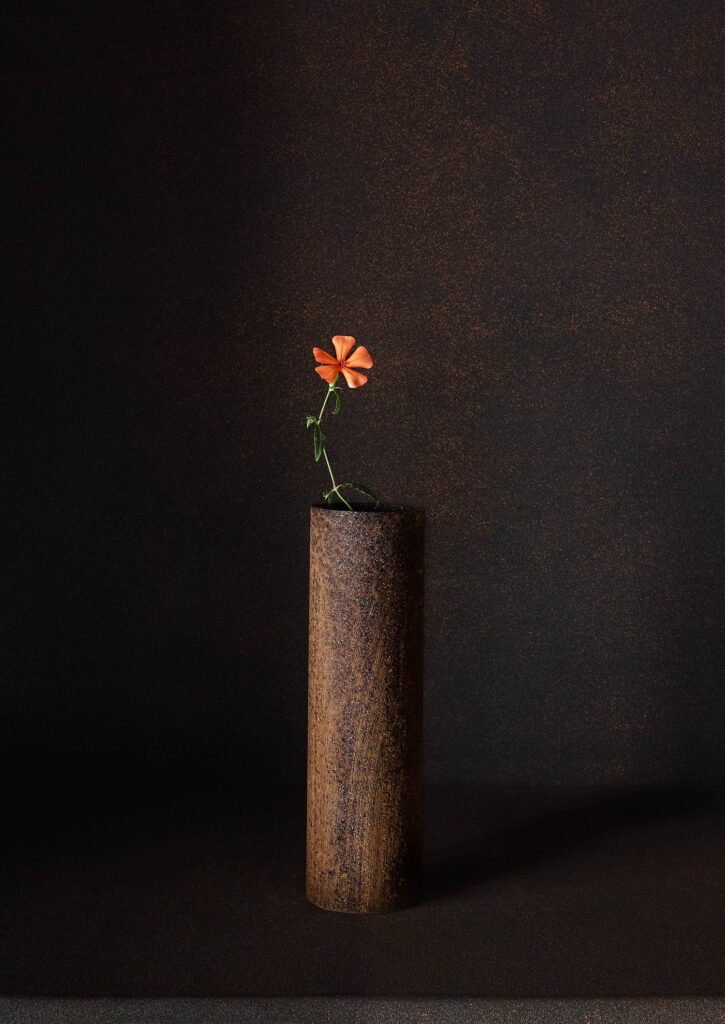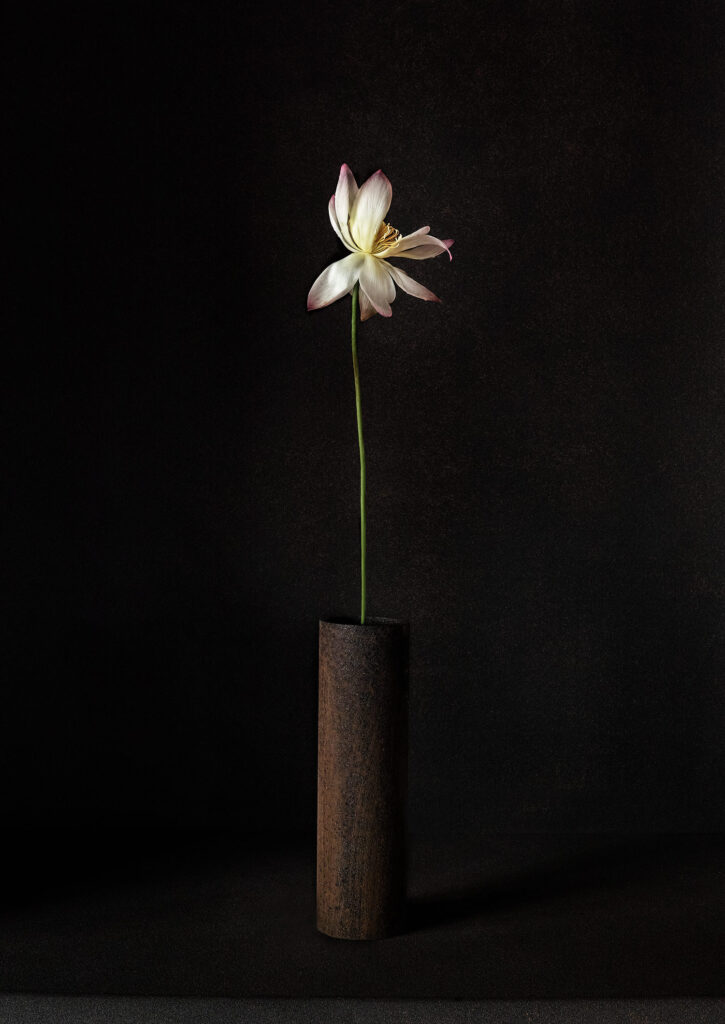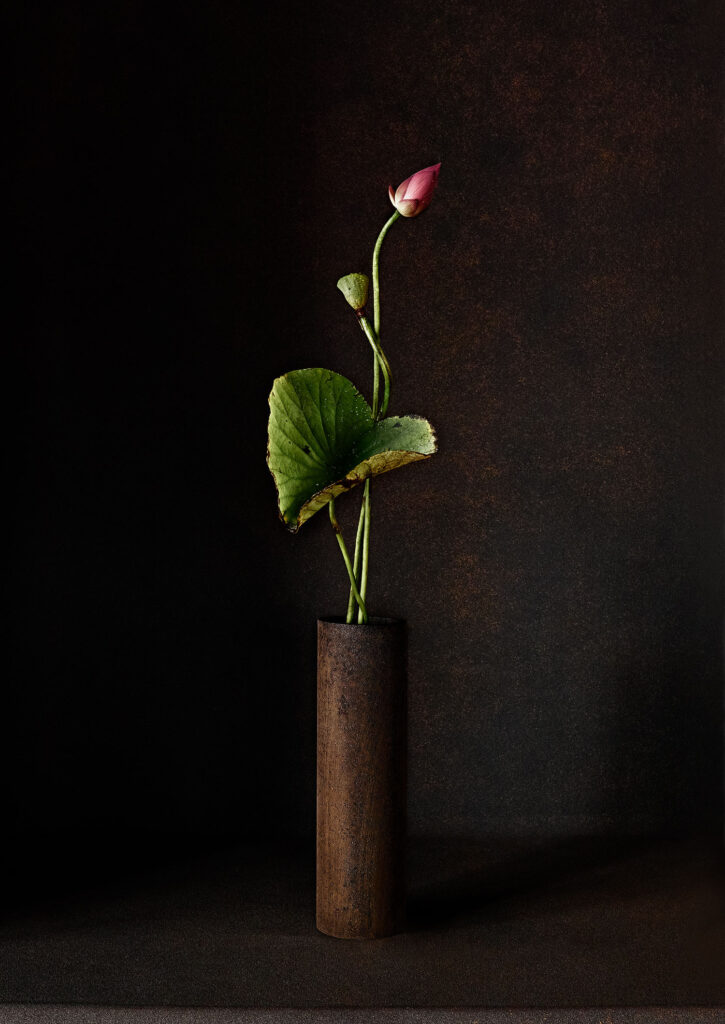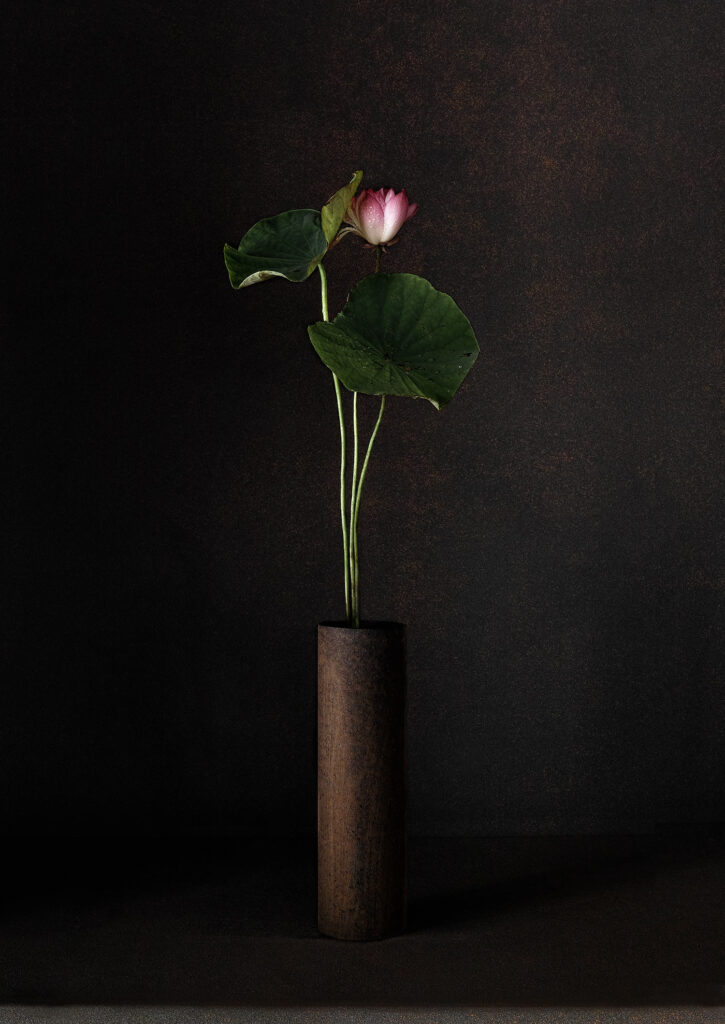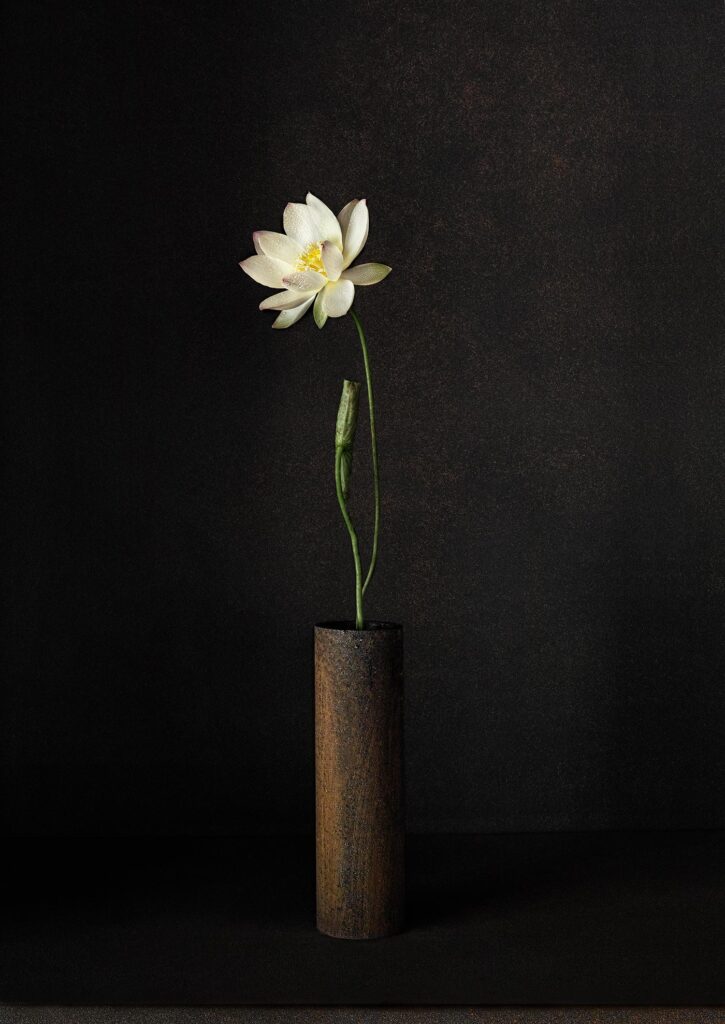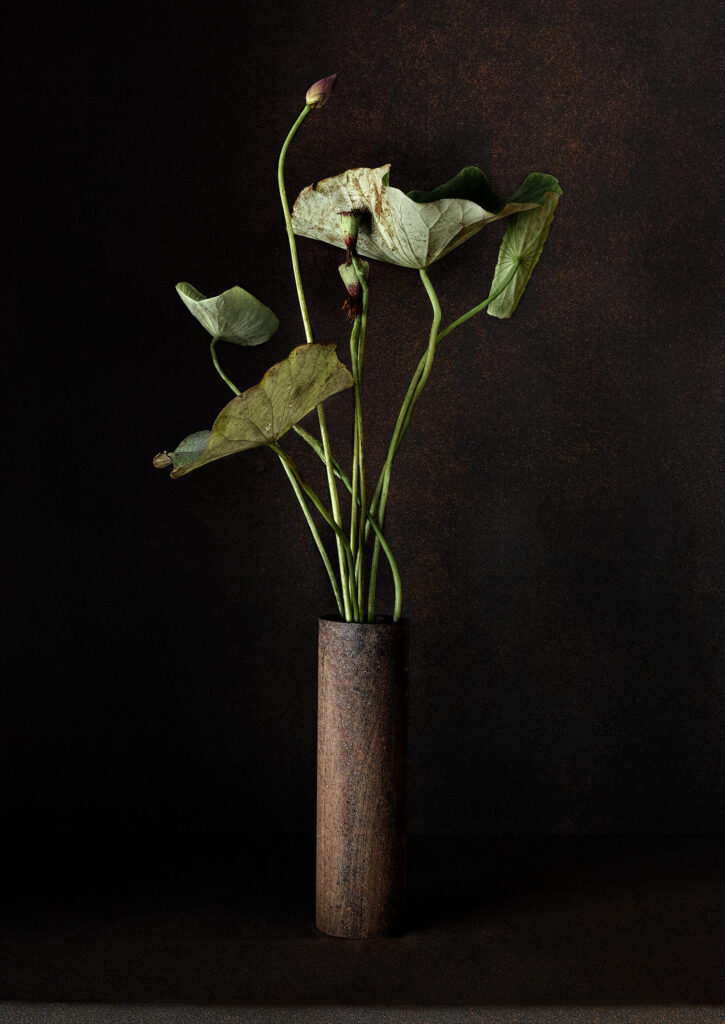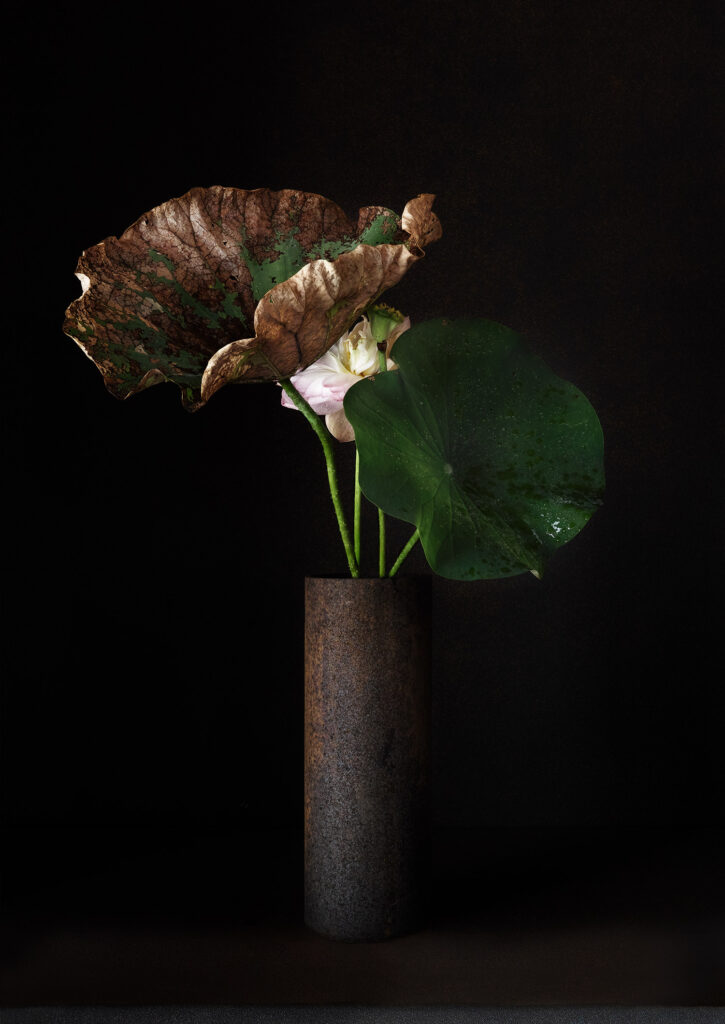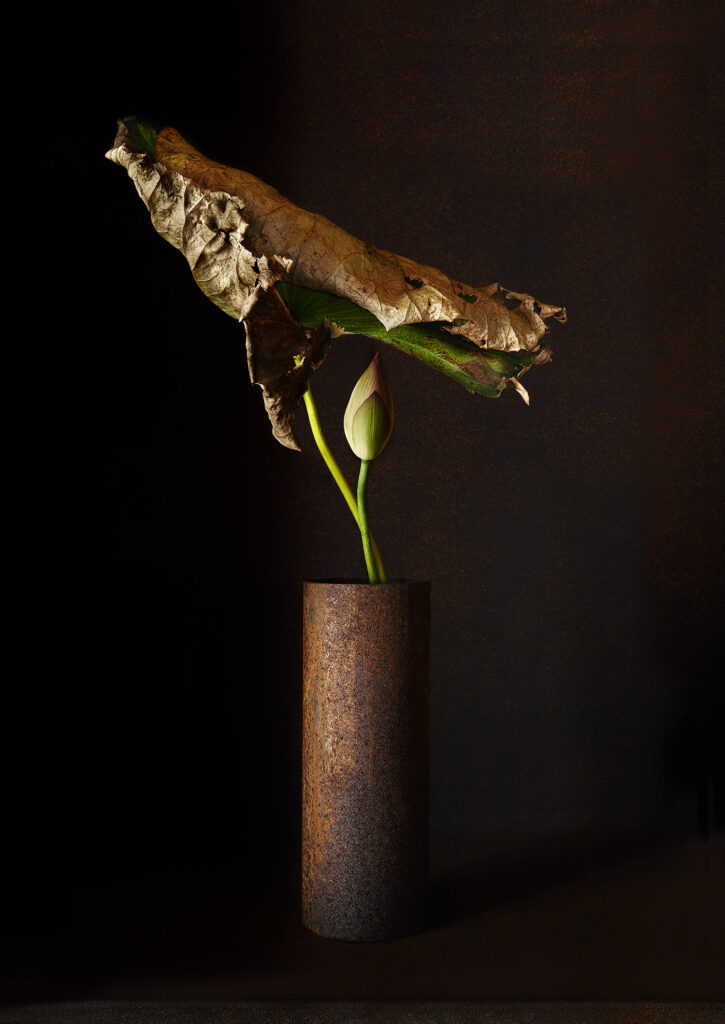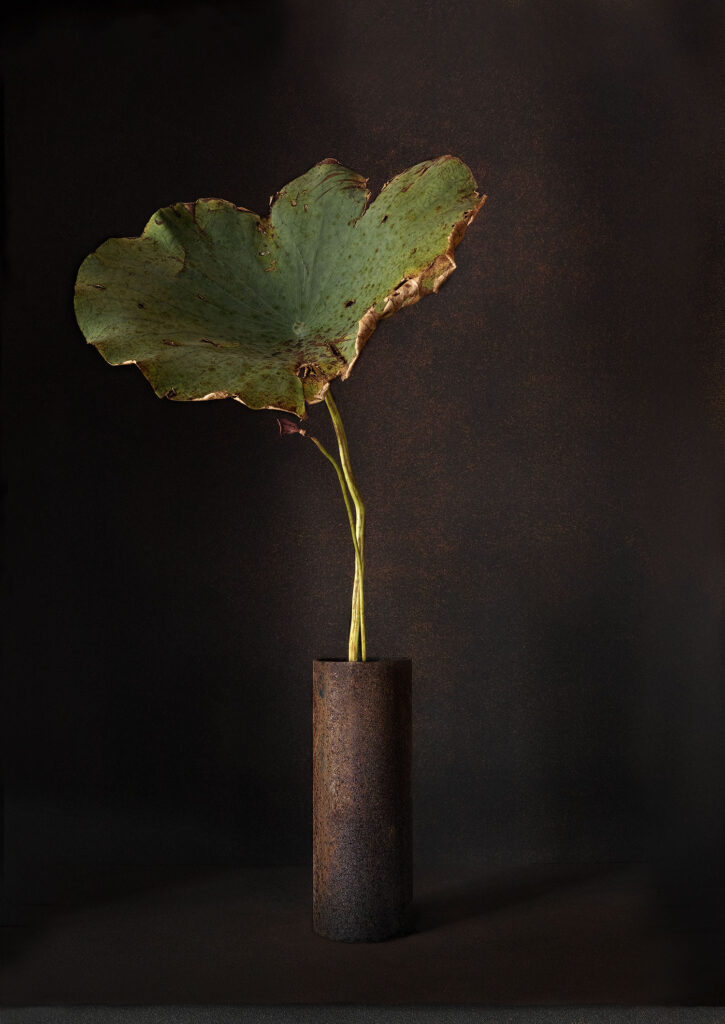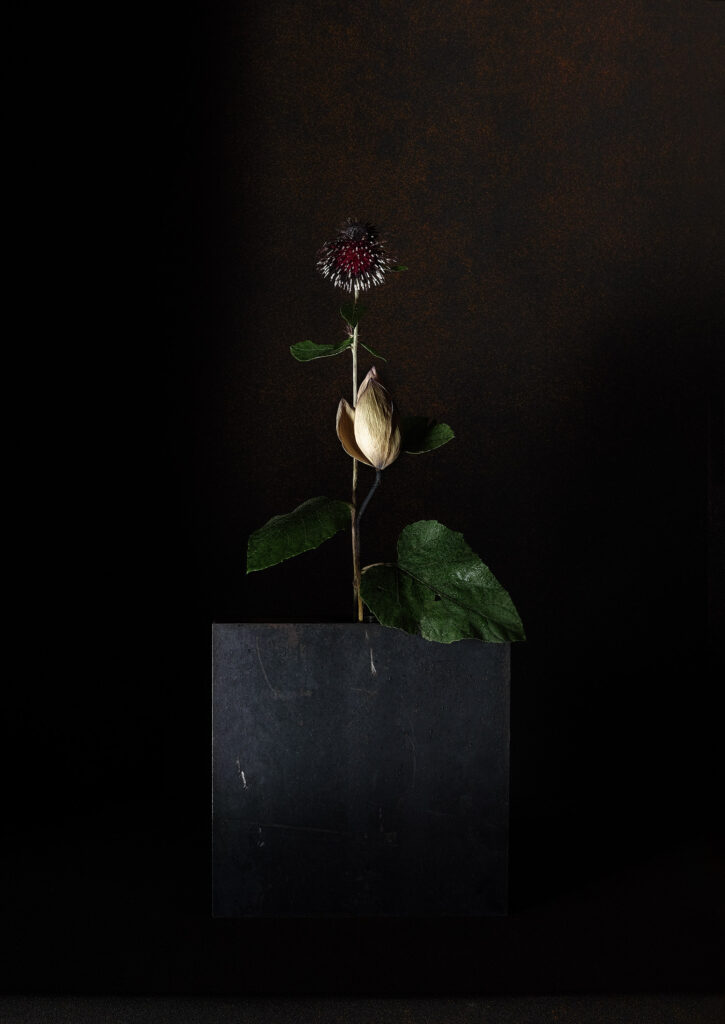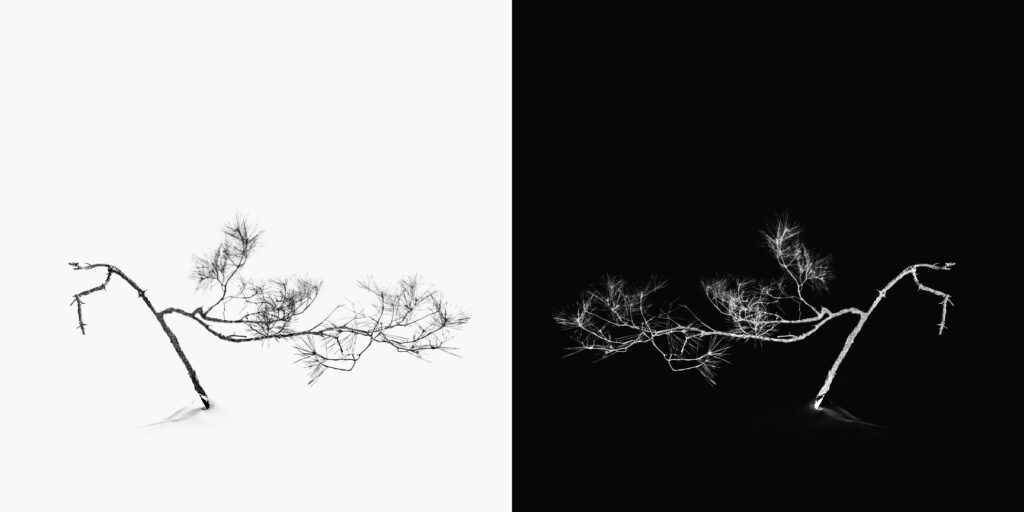
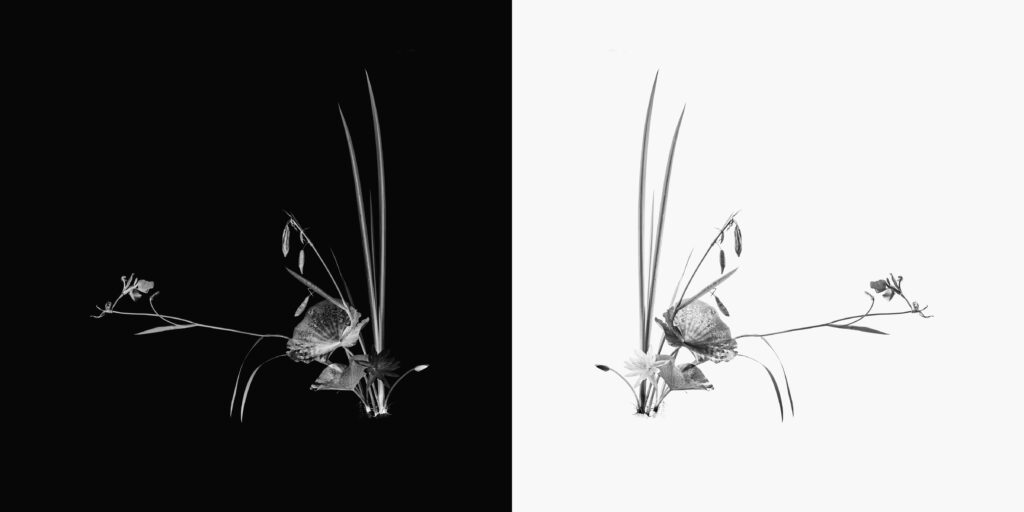

In the exhibition of this series, each silver-gelatin contact print is placed beside its inverted counterpart—either a digital negative or an inverted print. The images appear in pairs of white and black, echoing one another like reflections across shifting light. As in a linked haiku sequence, each paired work follows the next, creating a quiet rhythm in which the photographs seem to flow from one moment to another. Through this unfolding dialogue, the final print and its reversed shadow resonate softly, revealing two intertwined depths that dwell within the same silence.
17 Syllables – Echoes of Stillness (2025-)
At times, I imagine – if even those in conflict were to pause for a moment before the flowers I arranged and sense the quiet poem within them, perhaps something between them might soften.Through the quiet presence of flowers, I wish to create a moment in which time seems to stop,
a moment of silence shared with others. To “be silent together,” I believe, is a new form of dialogue – and perhaps the deepest kind of consolation. That belief lies at the origin of my work.
In my series 17 Syllables – Echoes of Stillness, I sought to incorporate into photography the quietude and layered minimalism inherent in Japanese haiku. For that purpose, I drew inspiration from Matsuo Bashō (1644 –1694) and his renowned poem:
An old pond;A frog jumps in –The sound of water.
(Furuike ya / Kawazu tobikomu / Mizu no oto)
This brief yet profound verse has had a decisive influence on my artistic vision. In Bashō’s late haiku, nature is not merely described; it becomes a bridge between external reality and inner perception. With the simplest elements – sound and silence, stillness and motion – he evokes a multi-layered world where time and space dissolve.
A key device in haiku is kire (“cut”), which interrupts the flow and gives rise to ma (“interval” or “emptiness”), expanding the reader’s imagination and sensory awareness. In Furuike ya, the particle ya signifies this cut. If it were Furuike ni, it would have remained a mere description of a scene. But through the brief rupture of ya, the reader imagines the pond, hears the splash, and feels the stillness that follows.
This structure became the foundation of my photographic expression. I collect flowers, branches, and grasses from the Japanese mountains, arrange them myself, and regard the point where the flower meets the water as the “cut.” Photographed in backlight against a white field, the image gives birth to a space filled with light.
A trace of snow may turn that blankness into a snowfield; a reflection may become the surface of a lake; a crack may suggest dry earth. In that moment, the empty space within the frame is quietly displaced – transformed into memory or imagination within the viewer.
This displacement of perception lies at the very core of the experience brought forth by kire and ma. It is the moment when the external landscape and the internal landscape of the mind gently exchange places – when the viewer sinks inward, and from a single silent “cut,” enters an infinite expanse of stillness.
Edition Details
Medium: Gelatin Silver Contact Print, Selenium Toned
Paper: Baryta paper (varies by batch)
Image Size: 25 × 25 cm (approx. 10 × 10 in)
Image Size: 48 × 48 cm (approx. 19 × 19 in)
Edition: Batch edition.
Prints are produced in sets of 3 from the same digital negative under identical conditions.
Each batch is released only after the previous one sells out, with prices increasing per batch.
Artist’s Proofs: 2.
Awards
Selected awards include BIFA 2025 (Budapest International Foto Awards), Gold Prize — “17 Syllables”, Professional / Nature / Flowers (among others).
Can Moment Last Forever? (2023-)
In this series, the artist embarks on a journey to unveil the intrinsic value of nature, contrasting the enduring nature of stone with the ephemeral beauty of ever-changing plants. The stones, born and evolving over time, starkly contrast with the fleeting grace of the plants. Personally arranging and photographing wild plants on blocks of ice, the artist overlays them with images of meticulously placed glass shards. This technique encapsulates the transient nature and beauty of the moment within the layers, portraying a delicate yet breathtaking instance in time. Against the backdrop of a winter snowy landscape, rocks and snow become the focal points of a minimalist composition, capturing the serene world of rocks, snow, and flowing river water. Through this visual exploration, the artist not only captures the profound beauty of nature but also contemplates the fragility inherent in each moment, seeking to express the preciousness of the natural world.
Awards
Selected awards include BIFA 2023 (Budapest International Foto Awards) Silver Prize, “Plate“, Professional-Portfolio/Fine Art (among others).
Can’t turn back time. (2021-)
This work is made by placing stones, wood, tree bark, fallen leaves, bird feathers, nuts, and other objects collected from the Iwakura ruins on a piece of calligraphy paper
Iwakura-iseki is the site of an ancient ritual. A group of giant rocks is considered to be the god’s retainer (i.e., a rock formation), and this rock formation is composed mainly of three giant rocks in the west, east, and north. Surrounded by tall, twisted trees such as cedars, the rock formation is surrounded by a different atmosphere, and still retains the atmosphere of the special place it once was.
The first step in this work is to carefully select several stones from among those collected and place them on a piece of paper. In arranging the stones, Keiichiro is conscious of the relationship between each stone as in a Japanese temple garden. He then gathers the stones that have fallen to the ground in the palm of his hands and scatters them from above. By creating a “space” where “order” and “disorder” coexist, He is attempting to express a “time of no return”. For the calligraphy paper, he used the belongings of hIs wife’s calligraphy master. Taking a bird’s eye view of the artifacts makes him aware of the separation of body and soul, life and death.
The objects collected from the remains are collected with permission and returned after the work is completed.
White Light (2020)
“WHITE LIGHT” is a series of works expressing “time and space” formed as a whole from conflicting relationships such as natural and artificial, bud and flower, and the back and front of a leaf. Keiichiro used aluminum shavings instead of mud to create the image of a person who lives a pure life untainted by their surroundings, like “a lotus in the mud”. The flowers are arranged by the artist himself. The paper used in the original print consists of a neutral paper and a plaster layer, the surface of which is further coated with its own plaster containing mica. The result is a natural and deep image quality that is full of life. The plaster provides a high degree of preservation.
Edition Details
Medium: Pigment inkjet print on paper with plaster-like coating
Print Size: A2 (approx. 42 × 59.4 cm / 16½ × 23¼ in)
Edition: 10 + 2 AP
Print Size: A1 (594 × 841 mm / 23⅜ × 33⅛ in)
Edition: 10 + 2 AP
Awards
Selected awards include IPA 2020 (International Photography Awards) 1st place, “White Light”, Professional-Nature/Flowers(among others).
IN HARMONY -SPARKLE-(2019)
Now is the time when people need “loving harmony”, isn’t it? The act of arranging flowers, trees, and grasses is an act of “interacting” with nature and creating “harmony”. Keiichiro arranges the flowers while projecting the appearance and shadow of the person onto them. When he does this, he feels the “sparkle” in the flowers. The “sparkle” is sometimes dazzling, sometimes soft, and sometimes gentle. When he feels the sparkle in the relationship between people and people, between people and nature, “love” is born. And he can be conscious of conflicting relationships such as yin and yang and creates “harmony” by superimposing the heart of each flower. “True harmony”, not just form and composition, is harmony with love. That is why he wants to bring “loving harmony” to the viewer’s home.
Awards
Selected awards include TIFA 2019 (Tokyo International Foto Awards) Silver Prize, “In Harmony-Sparkle-“, Professional-Fine Art/Other (among others).
Golden Light (2017)
The Parisian sunlight in June was strong, glaring, and impactful. Upon returning to Japan, at once, while the light shining in through the window of my atelier still generated a feeling as similar to the Parisian sunlight as possible, based on my fresh memory of it, He arranged flowers and produced the series of photographs. The series involves the presentation of lotuses while keeping in mind the notions of “moving” and “cutting off”, which arise out of the strong contrast between light and shadow, and focuses on “shiny, strong beauty”, which represents an aspect of the golden light.
Edition Details
Medium: Pigment inkjet print on paper with plaster-like coating
Print Size: A2 (approx. 42 × 59.4 cm / 16½ × 23¼ in)
Edition: 10 + 2 AP
Print Size: A1 (594 × 841 mm / 23⅜ × 33⅛ in)
Edition: 10 + 2 AP
Awards
Selected awards include IPA 2017 (International Photography Awards) 1st place, “Golden Light”, Professional-Nature/Flowers (among others).
A STAGE (2014-2015)
All the world’s a stage,
And all the men and women merely players.
by W. Shakespeare, “As you like it”, Act 2, Scene 7
Keiichiro uses the Tokonoma to resemble “A STAGE”. The Tokonoma is usually the alcove in a Japanese residence that is used to display special art, such as scrolls and flower arrangements. He makes a stage and a flower vase out of iron. The Tokonoma is a solemn stage upon which the true heart of flowers can be expressed.
“Flowers” are nature-made. “Iron products” are human-made. “Flowers” that are inserted in “Iron” now play a new role. The relationship created on the stage shines tells a story and is complimentary. Eventually, “Flowers” decay. “Iron” rusts. They return to their natural state. He reads the heart of nature continuously, through the act of arranging flowers and lets viewers feel the poetry of that heart.
Awards
Selected awards include PX3 2015 (Prix de la Photographie, Paris) Second Prize, “A STAGE”, Professional-Nature/Flowers (among others).








